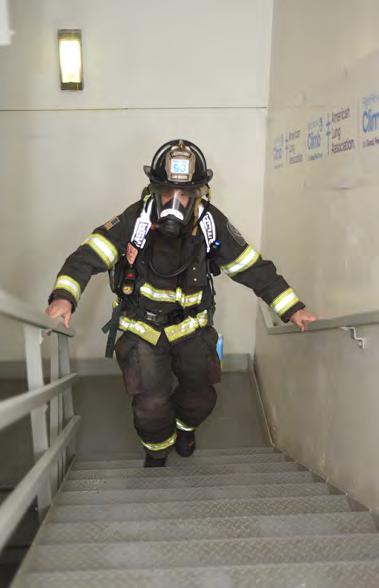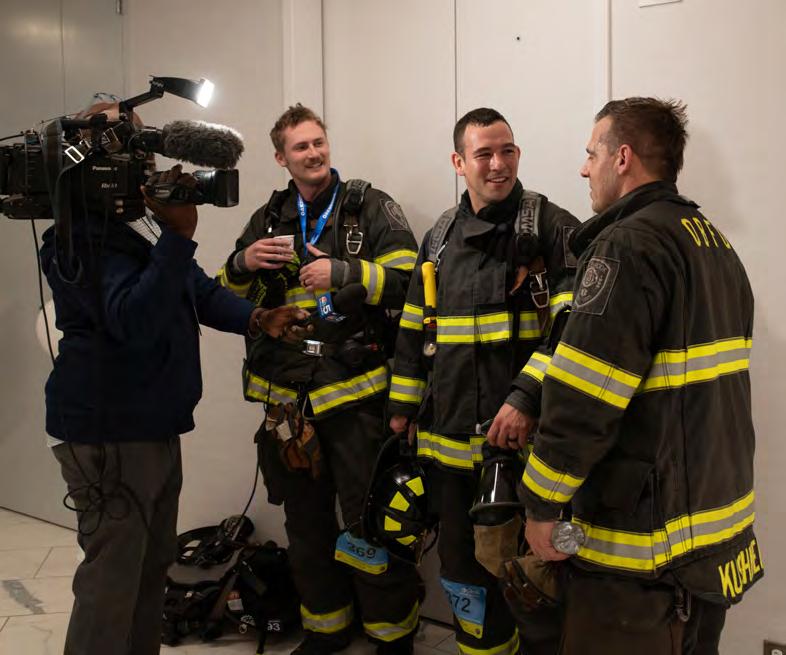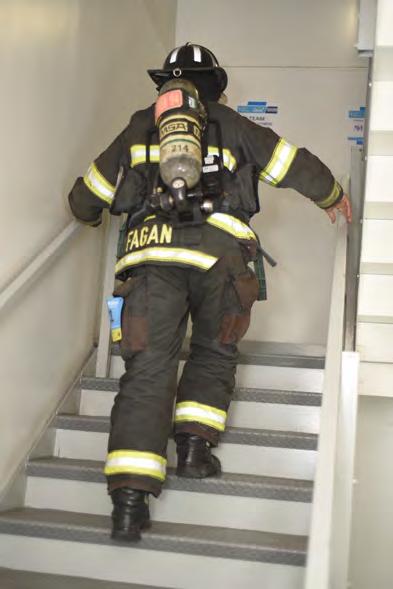
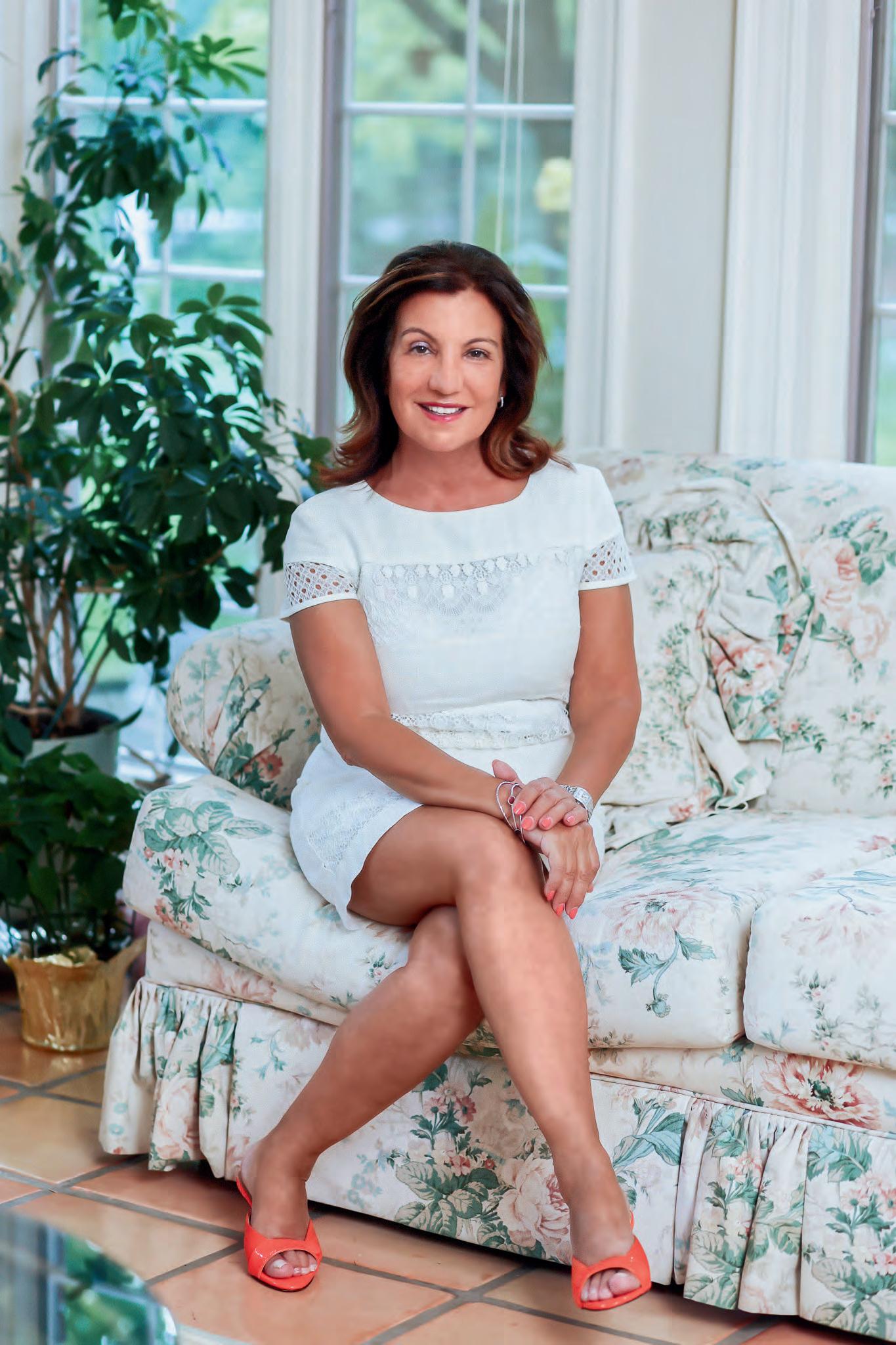
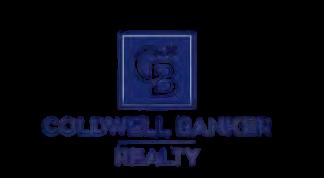

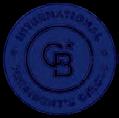

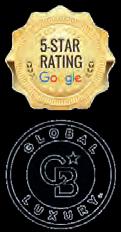

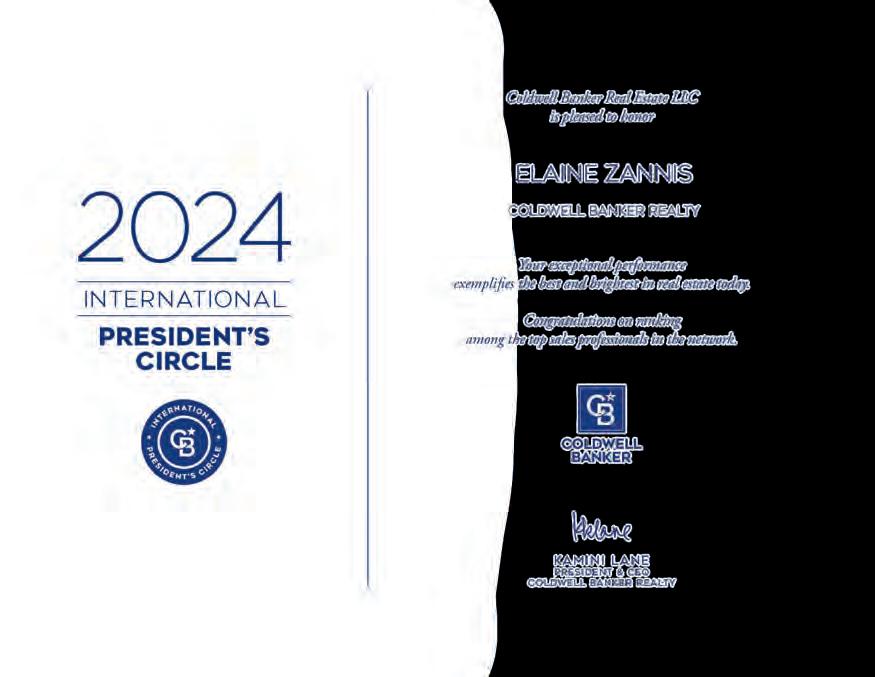

















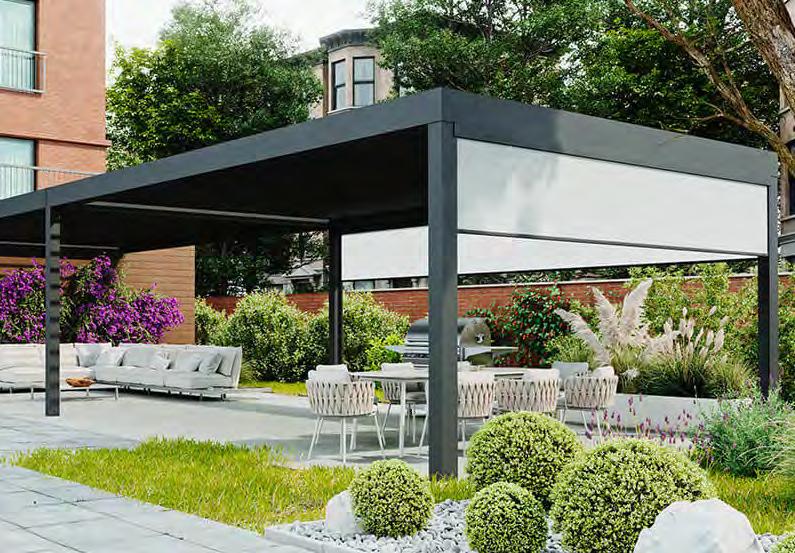
Skyvi Pergolas enhance any home with a sleek, customizable design. Available in dimensions up to 23’ x 16’ x 9’, they can be tailored with premium materials and features to complement your space.
With louvered roofs and side panels, Skyvi Pergolas adjust at the touch of a button. Choose from screen fabrics or glass sliding panels to create an enclosed retreat for year-round enjoyment.
Crafted from powder-coated aluminum and reinforced with stainless and galvanized steel, Skyvi Pergolas resist chipping, peeling, and harsh weather— standing strong against winds up to 68 mph. Plus, their ecofriendly production makes them a sustainable choice.
Perfect for patios, rooftops, or backyard escapes, Skyvi Pergolas also elevate commercial spaces, offering stylish outdoor comfort for patrons.
Skyvi Pergolas provide a high-end outdoor experience.









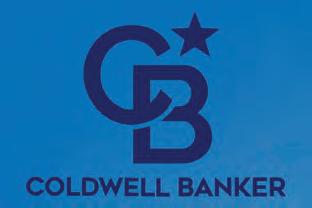

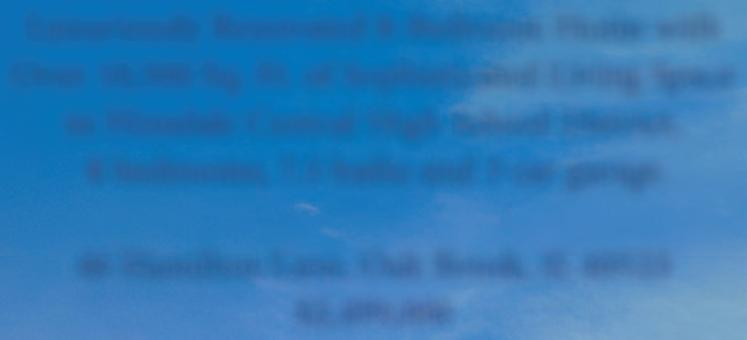
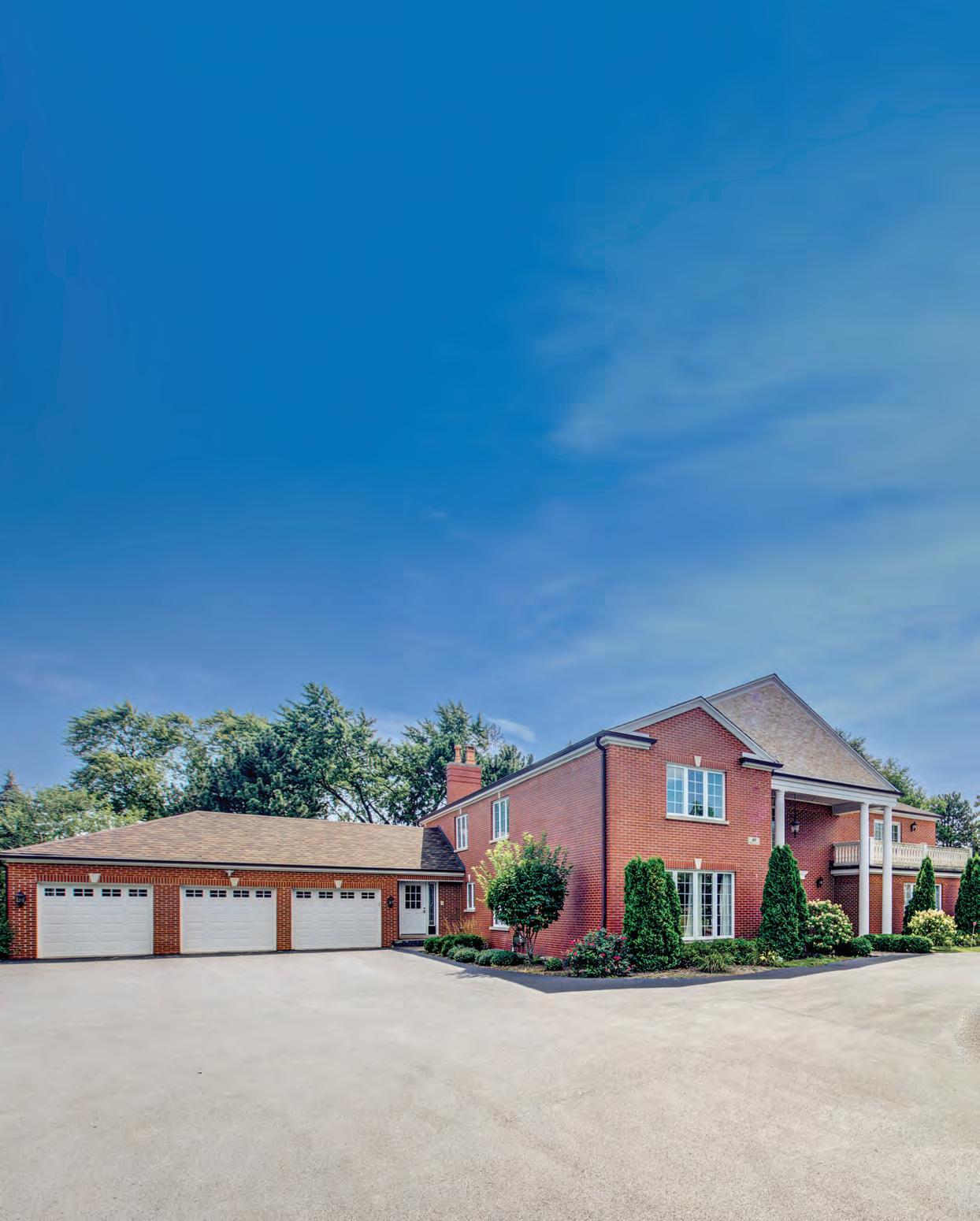
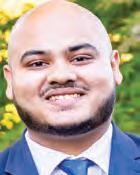







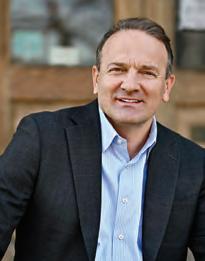
ere are just a few of many useful news items and positive stories for you to enjoy in this issue.
Our cover story on facial cosmetic surgeon Dr. Michael Byun leads an entire section on Noteworthy Doctors. This will be an opportunity to learn about leading doctors in our communities for your consideration.
In this section, we also bring you updates on achievements in medicine by local doctors and scientists. Thanks to Illinois doctors at several universities, fellow doctors worldwide are being shown how to work with AI, from data to diagnosis. At nearby Argonne Labs, the substantially upgraded Advanced Photon Source is now making it possible to use “smart” proteins to better monitor diseases like cancer and thyroid disorders.
May always feels like a month of movement—of blooming gardens, packed calendars, and hearts leaning toward summer. In this issue, that momentum is reflected in our stories—stories of purpose, persistence, creativity, and community.
President Andrew Limouris says, “We’re excited to be back in Oak Brook, ready to embark on our next phase of growth.”
We also like to bring you business success stories of individuals who are residents. Meet Mark Kaufman. He started Athletico, a company that offers physical therapy clinics. He opened his first one in 1991. Today, there are nearly 900 in 24 states and Washington, D.C.
Speaking of residents, parents, and leadership of the Butler 53 School District, got together to build a whole new playground that was badly needed for Brook Forest Elementary School. Credit everyone, including those who pitched in to raise over $250,000 with many fundraisers.

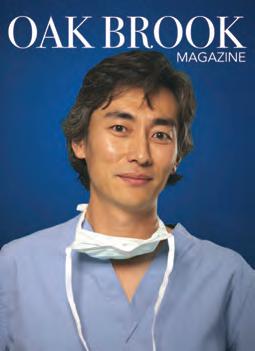

Before you know it, Oak Brook’s signature event, the July 3rd Taste of Oak Brook, will be here. Once again, some 40,000 will celebrate food, community, and entertainment at the Oak Brook Sports Core. From great food from Oak Brook restaurants to popular local bands, to the fireworks and drone show, it will be the place to be. Admission is free.
One of the other signatures of our unique community is Oakbrook Center. Maureen Callahan teamed up with the Oak Brook Historical Society to take you back to the early days of what has become one of the leading shopping centers in the world since it opened in 1962.
Business leaders recognize all that Oak Brook offers. Village President Larry Herman recently welcomed back Medix Staffing Solutions. The company started in Oak Brook 23 years ago in an 8 x 10-foot office. Today, it is in nearly 50 states and decided it was time to come back to Oak Brook. As
In the sports arena, we celebrate achievement through discipline and effort. The Hinsdale Central 200-yard medley relay swim team shattered a national high school record with precision and heart, and the entire team went on to win its third straight state swim championship.
In another somewhat related athletic endeavor, in March, the American Lung Association ran its 32nd Fight for Air Climb at Oakbrook Terrace. Hundreds participated in the 30-floor climb, including four members of the Oak Brook Fire Department who raised $1,000.
Other articles you will enjoy include the 250th anniversary of the United States Army. It was led by none other than George Washington.
Another piece of history: One great vacation—if your family is into baseball—is a trip to Cooperstown. Every summer, thousands of 12-year-old athletes get a chance to play on one of two beautiful fields.
Enjoy the articles and the summer before us.
Scott Jonlich Publisher Oak Brook Magazine
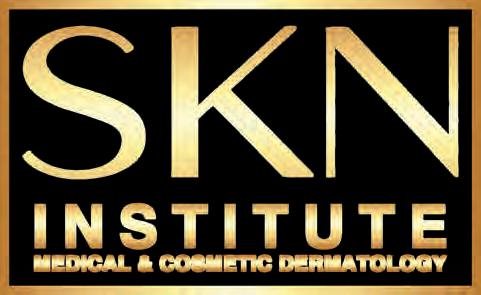
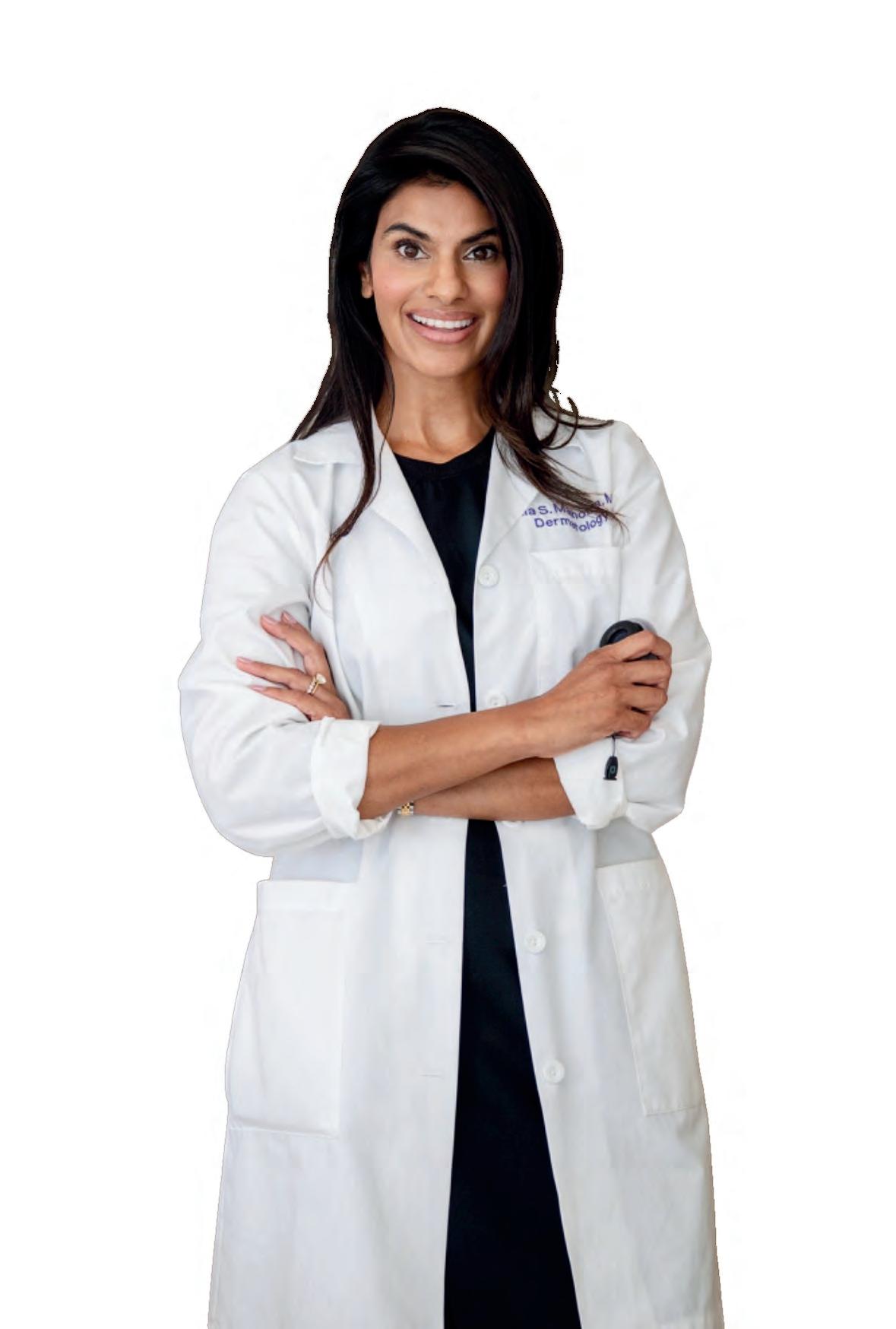

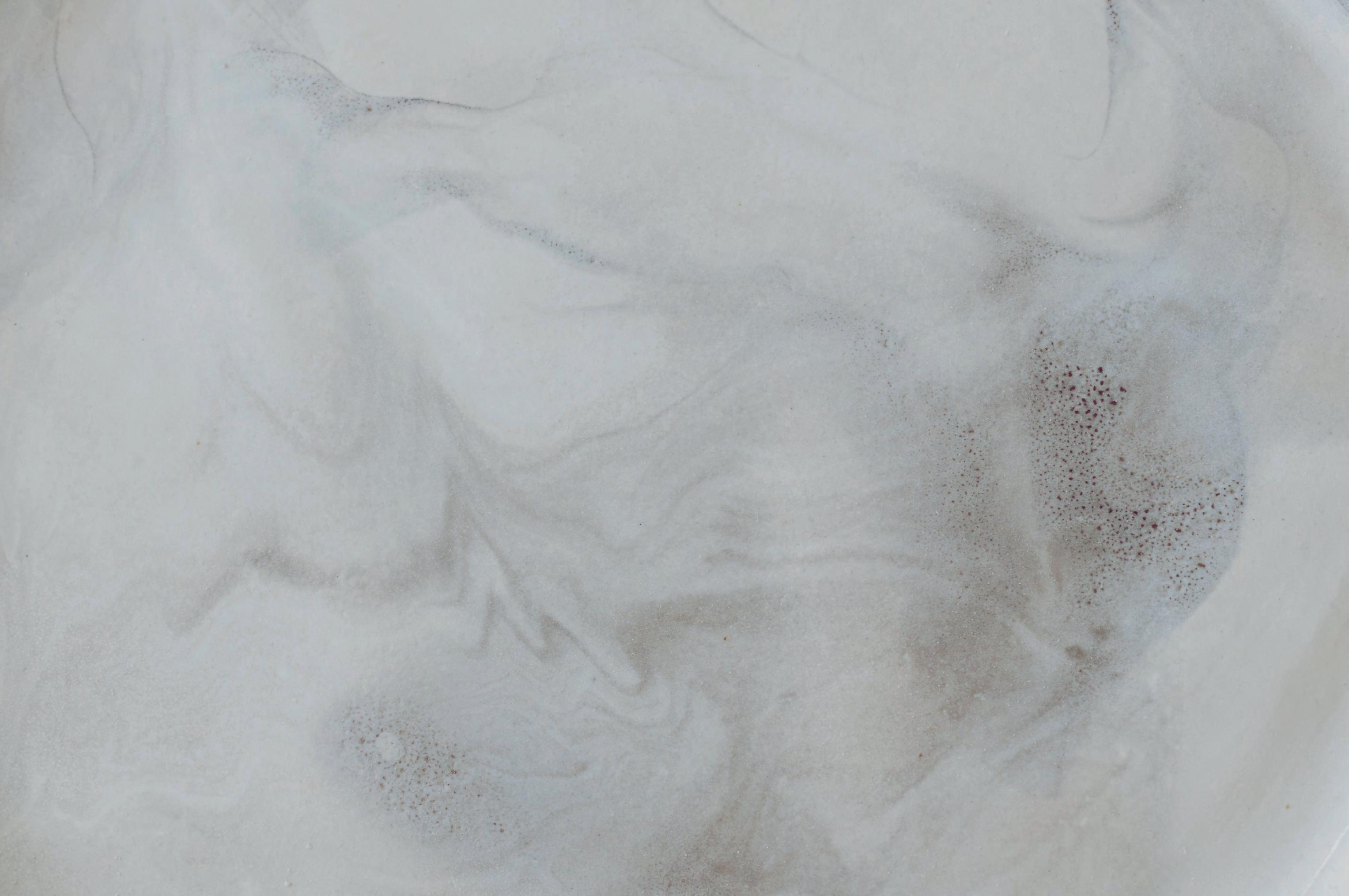
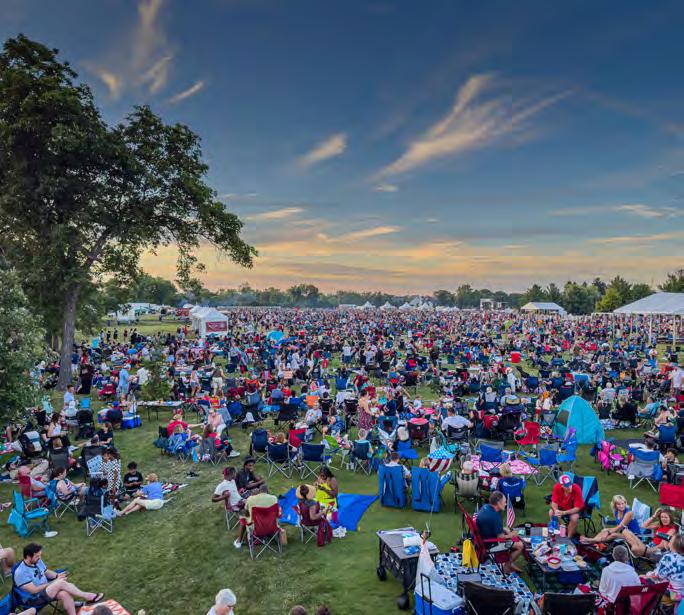
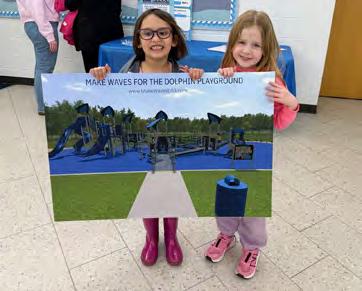
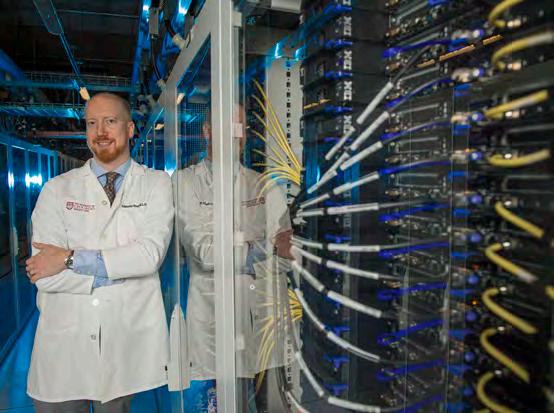













FOUNDER & PUBLISHER
Scott Jonlich sjonlich@HinsdaleMag.com
GROUP PUBLISHER & EDITOR
Anne Healy anne@HinsdaleMag.com
MANAGING EDITOR
Larry Atseff larry@HinsdaleMag.com
CONTRIBUTING EDITORS
Maureen Callahan
Valerie Hardy
Anna Hughes
GRAPHIC DESIGNERS
Jennifer Frencl
Rachel Pavlovich
Katie Bolinger
CONTRIBUTING WRITERS
Bill Esbrook
Chuck Fieldman
Jack Rodak
Jeff Vorva
FEATURE PHOTOGRAPHERS
Victor Hilitski
Greg Kozlick
Atticus Fair, Video Editor
ADVERTISING SALES graphics@hinsdalemag.com
Hinsdale Magazine Group
3 Grant Square #201 Hinsdale, IL 60521 630-655-3400 OakBrookMagazine.com
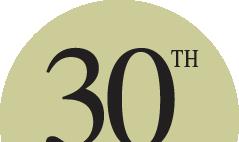

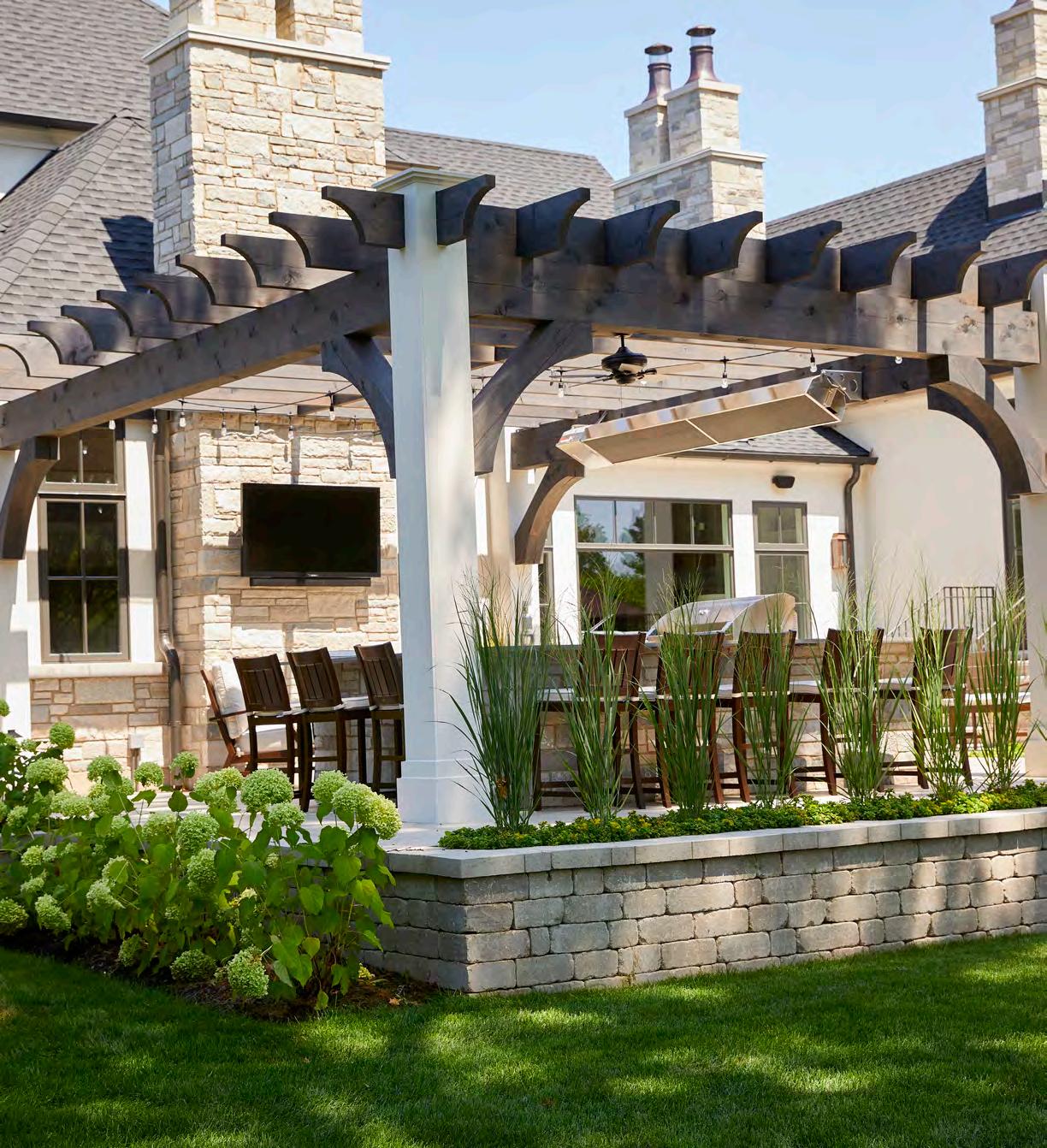

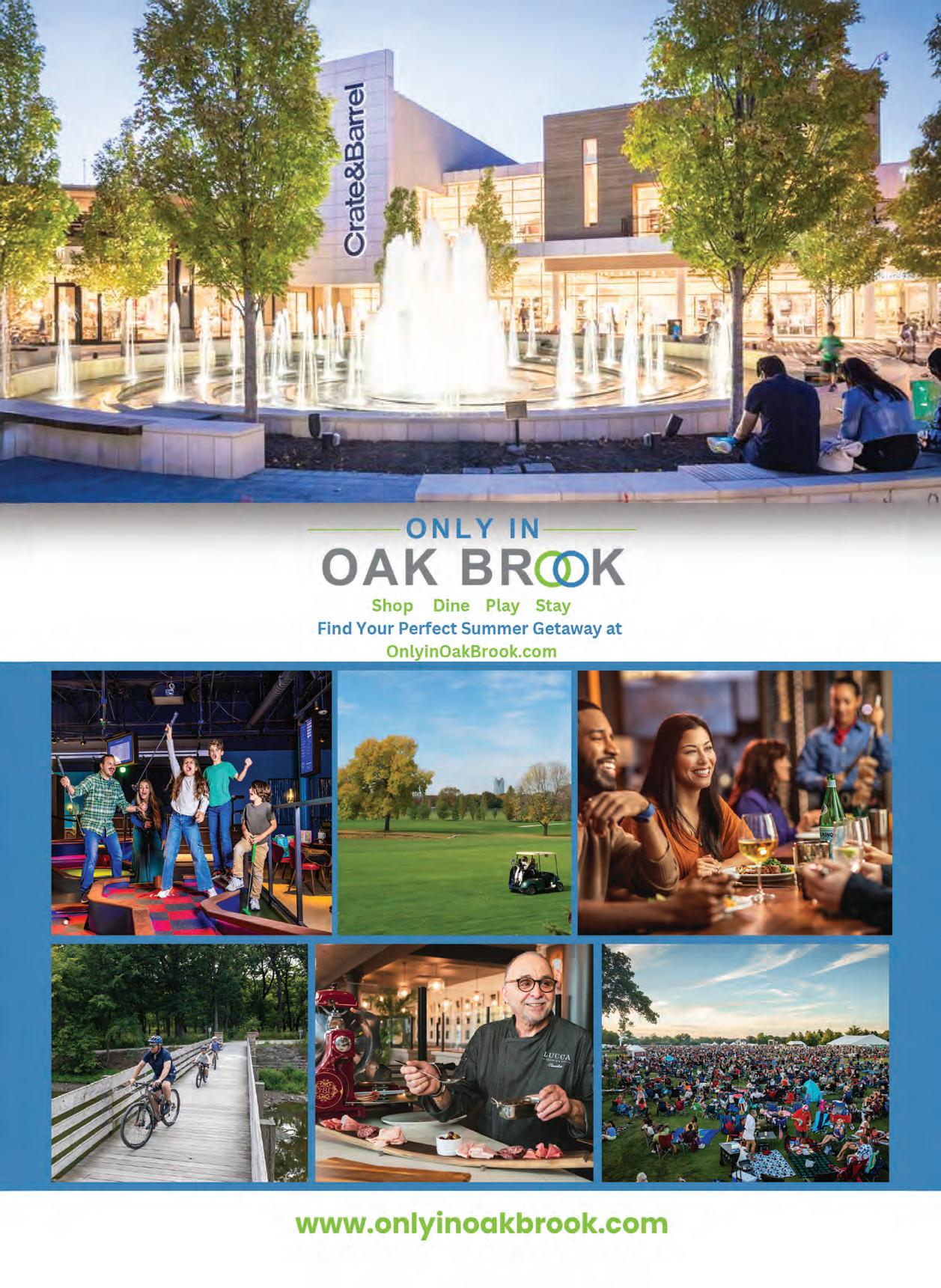


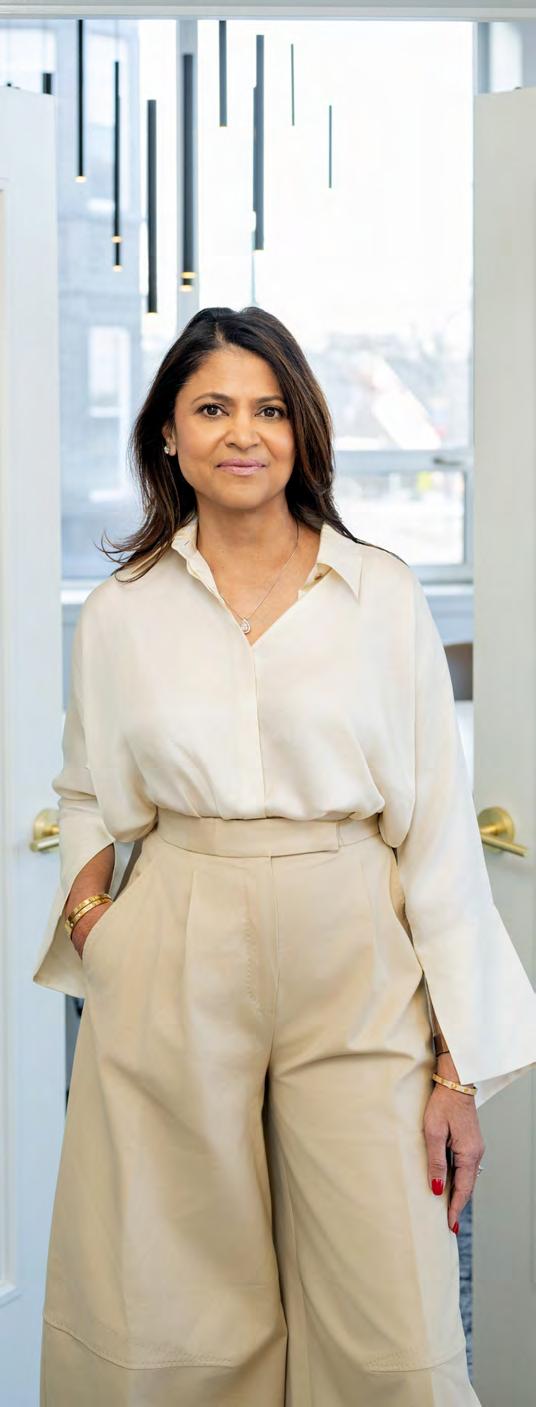

a reputation for delivering results with integrity, strategy, and an unwavering commitment to my clients.
Ranked in the top 2% of my network, I bring a unique blend of market expertise, construction knowledge, and multimedia marketing to every transaction. As a 37-year Chicagoland resident, I understand the nuances of each neighborhood— from schools to pricing to lifestyle—and use that insight to help my clients make confident decisions.
My approach is personalized and results-driven. Whether selling a family estate or purchasing a dream home, I guide clients every step of the way with sharp negotiation, customized strategy, and concierge-level service.
Top 2% of agents for over a decade
25% of listings sold privately—many with multiple offers
Customized marketing: digital, print, social, and staging
93% list-to-sale ratio
Avg. days on market: 28
$1,005,000
With summer break fast approaching, we’ve curated a list of local activities for the entire family to enjoy. Whether you’re looking for memorable musical performances or fun in the sun, we’ve got all that and more on this season’s selection of the best in the western suburbs.
BY ANNA HUGHES
Paramount Theatre Aurora April 30-June 15 ParamountAurora.com
Paramount’s creative team has re-envisioned this classic musical, bringing a new layer and energy to this Broadwaystaple. Cats was inspired by a collection of poems by T.S. Eliot, from which the legendary Andrew Lloyd Webber crafted an unforgettable score and story. The show has been bringing audiences into the fantastic world of Jellicle Cats since its inception in 1981. Cats is the winner of seven Tony Awards, including Best Musical, Best Book of a Musical, and Best Original Score. Showtimes vary by date.
INAUGURAL
ELMHURST HISTORY MUSEUM CONCERT
June 6, 6:30 PM Elmhurst History Museum ElmhurstHistory.org
The Elmhurst History Museum is celebrating the opening of their new public, outdoor performance space with an inaugural concert,
and they want you to join in on the festivities! There will be a ribbon cutting and remarks from the museum team before a performance by the Elmhurst Symphony Orchestra. Guests can bring chairs, blankets, and coolers, and the event is free to all attendees.
HINSDALE FINE ARTS FESTIVAL
June 7-8, 10 AM-4 PM Burlington Park HinsdaleChamber.com
The Hinsdale Chamber of Commerce proudly presents the 52nd Annual Fine Arts Festival. This summer staple during the first weekend of June brings people from all over the Chicagoland area to Hinsdale. Walk
through Burlington Park, and enjoy a variety of booths featuring unique, classy, and fun fine art from over 85 different artists.
ELMHURST CENTRE FOR PERFORMING ARTS: AN INTIMATE EVENING WITH MIGUEL CERVANTES

June 12 at 7:00 PM Hammerschmidt Chapel in Elmhurst ECPA-Elmhurst.org
No one has been Hamilton longer, except Alexander himself. Best known for the role of Alexander Hamilton in the Chicago and Broadway productions of Hamilton for nearly


eight years, Miguel Cervantes grew up in Dallas where he attended Booker T. Washington followed by Emerson College, where he earned his BFA. ECPA presents “An Intimate Evening with Miguel Cervantes” with guest artist Julie Peterson (York HS 2010; The Boston Conservatory BFA, 2014).
SONNY ACRES PRO RODEO
June 13-14, 20-22
Sonny Acres Farm SonnyAcres.com
Grab your hats and boots and saddle up for a local experience like no other. Sonny Acres Farm proudly presents their 3rd Annual Pro Rodeo, complete with

Experience Chicagoland’s Ultimate Sky Show with Spectacular Fireworks and a Dazzling Drone Show
THURSDAY July 3 Gates Open at 4pm Sky Show at Dusk FREE ADMISSION Plus! Kids Entertainment: Inflatable fun, face painters and more!

For pre-purchased parking and more information visit: www.oak-brook.org/taste

Enjoy “Taste” Size Portions from your Favorite Local Restaurants
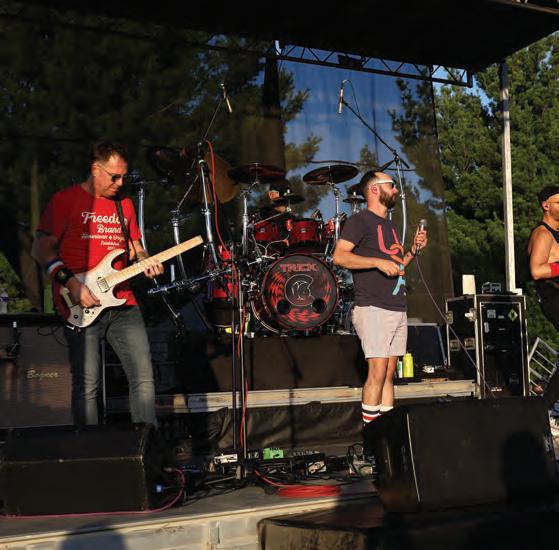

Live Music featuring (Unofficial Taylor Tribute Band) Returning Headliner












“It’s one thing to talk about an idea, but to have renderings and a proposal at the starting point goes much further,” Pesek shared. “Once I had renderings, I could go to the administration with some of the work already done. They were very receptive and started the appropriate vetting process.”
From there, the project was introduced to the school architect, construction manager, teachers, staff, and students. District Superintendent Dr. Paul O’Malley formed the Playground Advisory Committee, which allowed parents to perform playground site visits of recently completed area playgrounds and weigh in with ideas. Students were given surveys of what they might like to see at a new playground. Designs began to form based on feedback from these various groups.
Every year, the school district generates a capital needs report. Playground replacement, while recognized on the list, fell among nine or 10 other big-ticket items. Over the past few years, the district embarked on a $20 million dollar capital improvements project for classroom renovations, technology upgrades and school security. The installation of these necessities was dovetailed with unforeseen e-learning during the pandemic. While playground updates were on the list, they weren’t the first item.
A petition went out to the community to highlight support for the idea of a new playground. Pesek and his wife, Jackie, along with other district parents, Resham Mendi, Seana Scheid, and Jen Skinner met with the Parent Teacher Organization (PTO). A Playground Subcommittee, to be backed by the PTO, was formed. “Anthony had approached me a few times before I initially agreed to be part of the subcommittee,” said Mendi. “But when I saw how serious he was about the initiative, I knew I wanted to be part of it. He has done an amazing job.”
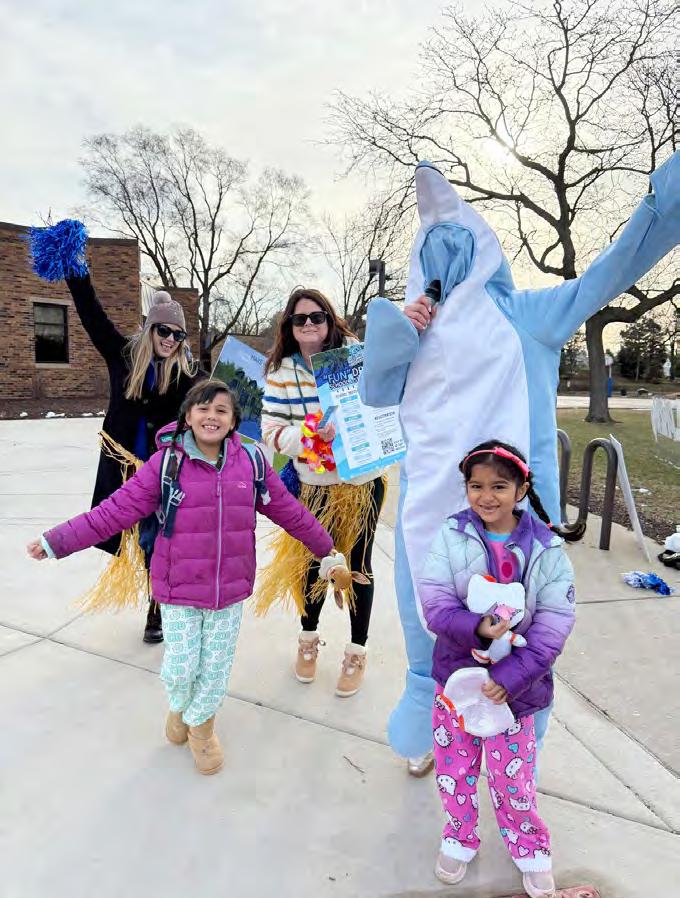
To gain a better understanding of what needed to be done, the group met with representatives from District 181 (Hinsdale) who had updated several of their school playgrounds over the last few years. “The advice 181 gave us, along with the support of our Superintendent, Dr. Paul O’Malley, has been indispensable throughout this process,” Pesek acknowledged.
Not long later, the group presented their case at a school board meeting to move the project forward and gain fundraising approval.
The Playground Committee was thrilled when the board not only agreed to allow the effort to proceed but also threw their proverbial hat
into the project by agreeing to incur some of the additional costs beyond the equipment, such as demolition of the existing park, installation, concrete work, drainage, and new playground surfaces.
So began the biggest fundraising campaign in Butler 53 school district’s history – Make Waves for The Dolphin Playground. The board officially stamped its approval to fundraise on March 10. Two days later, fliers went home with students to formally announce the capital campaign. During PTO Match Week, the committee learned their efforts would be generously matched after they raised the initial $100,000 from PTO reserves. $100,000 quickly surpassed $200,000.
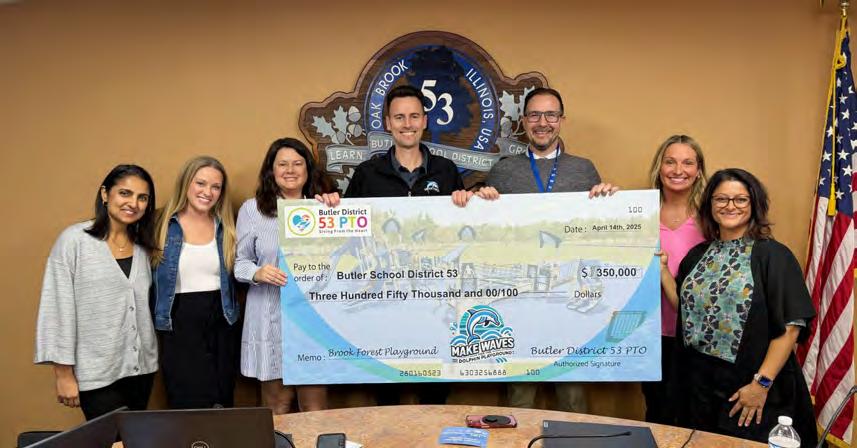
Everyone got on board. To keep interest levels up while raising money, incentives included rewards like pizza parties, ice cream events and magic shows as they hit various fundraising milestones. Many businesses contributed, as well as the Village of Oak Brook, both financially and

through publicity in village communication. The Brook Forest Homeowners Association also pledged financial support.
Superintendent O’Malley is thrilled with the outcome. “There are some very dedicated dads and moms in this

district,” he acknowledged. “They’re an amazing group that speaks miles about the commitment of parents in education.”
At the time of publication, the Make Waves for Dolphin Playground campaign surpassed the fundraising goal of $256,117 propelled by continuous community support. If all goes as planned, construction will take place over the summer and be ready by the time school opens for the 2025-26 school year. And that’s how a successful, well-executed, grassroots campaign organized by a few committed citizens can make all the difference.
Please visit MakeWavesD53.com to learn more about the new playground and community efforts. ■
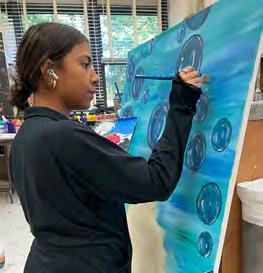

Trinity High School sets the standard for excellence in education with 100% college acceptance and $182 million in scholarships awarded over six years (an average of $400,000 per student).
With our all-girls Catholic education and the prestigious International Baccalaureate curriculum, Trinity empowers young women with the confidence and skills to excel in college—and beyond.
Find out more information on 7th & 8th Grade Shadow Opportunities, 8th Grade Entrance Exam, and private tours.
Transportation available. n




NO initiation fee
NO tennis court fee
New for 2025:
• Aqua climbing wall
• Expanding seating and sunbathing area
• New food options plus specialty themed meals and drinks at our Pool Café
Back by Popular Demand:
• Exciting events including Movie Nights, Luau Day, Tie Dye Day and Swim & Save with Wintrust Bank
• Pool Obstacle Course
• British Swim School with professional swim lesson instruction
• Swim Team
• Fluid Running
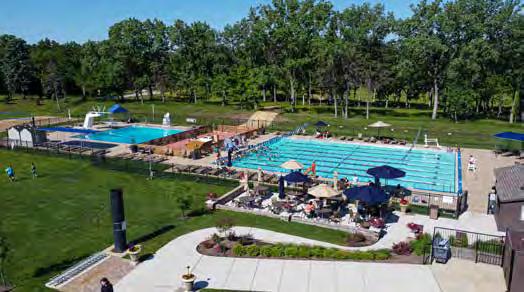
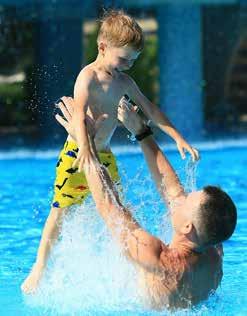


• High caliber tennis instruction for both adults & children by professional Ryan Rader •
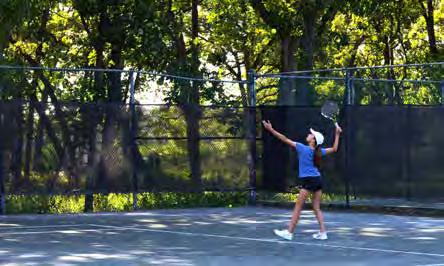

The builders and designers of Oakbrook Center had a much greater vision- to bring to life the biggest shopping center in the Midwest and one of the biggest in the country at the time. But even at 110 acres and over a million initial square feet under the roof of retail space – it was never just about size but also distinctive architecture and an elaborately landscaped plan. They also proposed offering the finest shopping facilities available to consumers anywhere. But that was just the beginning of the distinct, proposed mall.
They succeeded! The groundbreaking ceremony on Arbor Day, 1962, saw the beginning of the realization of this vision.
Heavy hitters such as Stanley Field, nephew of Marshall Field and Director of Marshall Field & Co., and Charles Kellstadt, President of Sears, Roebuck & Co., as well as Paul Butler and the mayors of Oak Brook and Oakbrook Terrace, were present the day the plot of farmland at the northeast corner of Route 83 and Butterfield Rd., became Oakbrook Center, a new concept to the retail shopping world.
care of as well as doctor and dental appointments in the adjacent professional building. Since the beginning, Oakbrook Center has brought community to the town.
There’s an atmosphere about Oakbrook Center that literally reinvented the idea of an urban retail experience. Something about being able to walk outside the entire time one shops offers a sense of freedom. There’s a carefree feeling about floating from department store to boutique to restaurant en plein air.
to wander through rows of shined and polished antique cars displayed on the concourse outside Saks Fifth Avenue.
Anything needed for back-to-school shopping could be found at Oakbrook Center, and everyone knew it. The latest styles and trends were all waiting to be acquired before school opened, complete with fashion advice from well-trained salespeople. The yearly art show brought in artists from across the country to sell unique paintings, jewelry and other one-of-a-kind pieces each September.

People sometimes came to walk the mall on warm evenings even after the stores had closed.
Since the beginning, Oakbrook Center has fulfilled many needs for a town without a central business district. In addition to clothing, jewelry, shoes and other department store finds, the original mall had a Walgreens, as well as a grocery store. Shoppers could drop their cars off for service at Sears while they had lunch at The Magic Pan crêperie or Henrici’s. Banking could be taken
The seasons were distinct and memorable in the outside setting. Locals recall strolling next to immaculately laid-out tulip beds surrounding the fountains in the spring while shopping for Easter clothes and shoes. This mall was amazing in warm weather, as Wednesday evenings saw entire subdivisions of neighbors sitting together on the grass outside the gazebo – a mall landmark - listening to bands, often locally sourced, but sometimes names as big as Frank Sinatra Jr., as the kids licked oversized Häagen-Dazs ice cream cones. The Father’s Day auto show each June attracted car enthusiasts
Shoppers dashed quickly from storefront to storefront in search of holiday treasures – and sometimes had the unexpected luck of finding the perfect gift as they ducked into a store for a brief reprieve on a bitterly cold day. At night, the outdoor mall became a fairyland of twinkling lights all lit up for the holidays. Even window shopping at that time of year was magical, with stores competing for the eye of the passerby through elaborate holiday displays.
While each store had its own brand of panache, the beacon of style, service and elegance was the anchor store, Chicago’s own Marshall Field & Company. Marshall Field himself built a wildly successful business and trained staff to act on his motto, “Give the lady what she wants!”
From gifts to wedding registries to special occasion clothing, the iconic
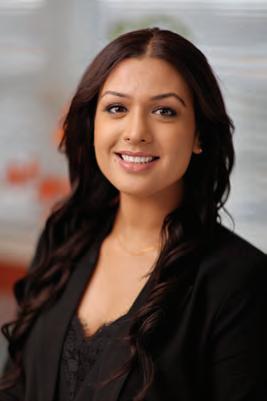
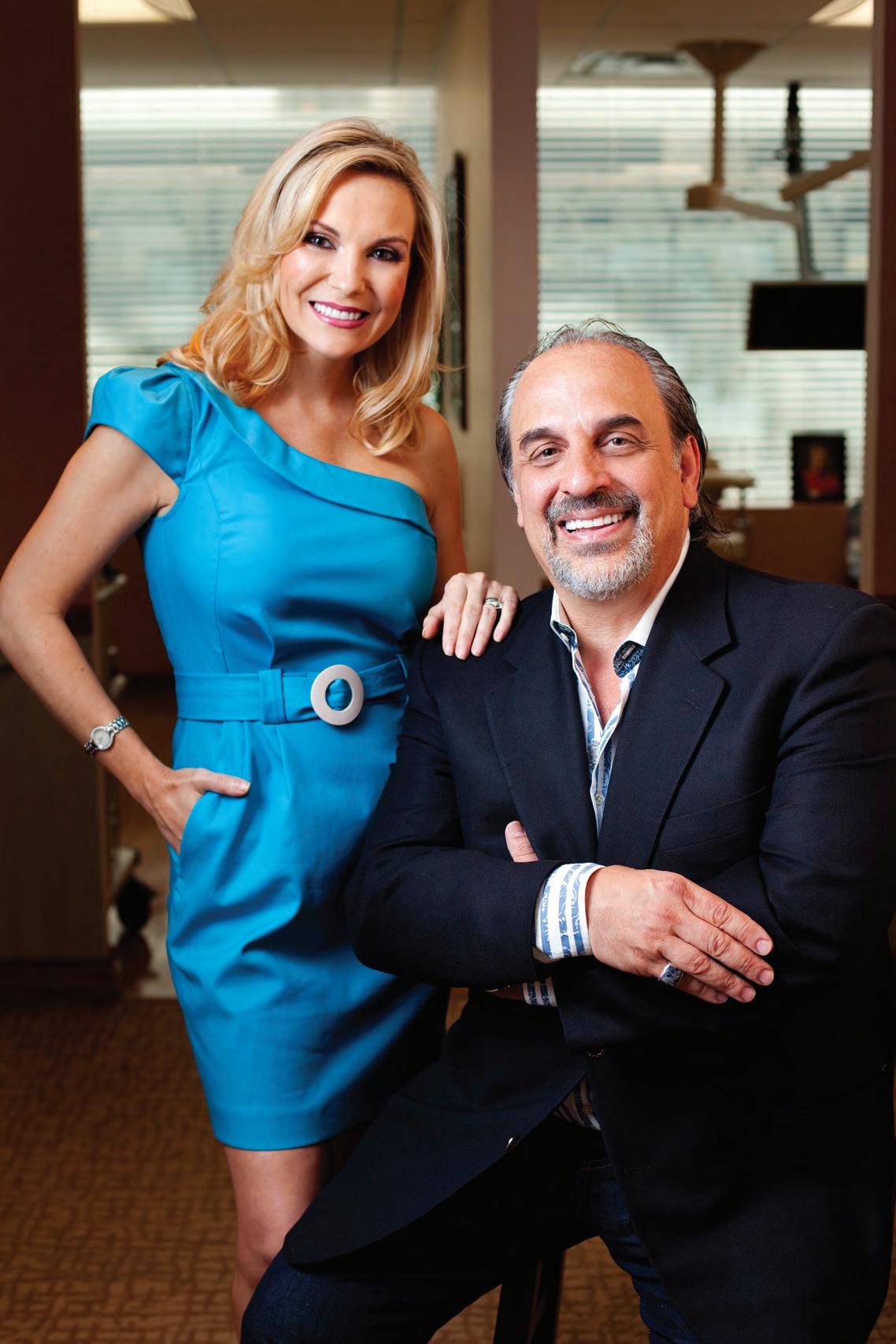
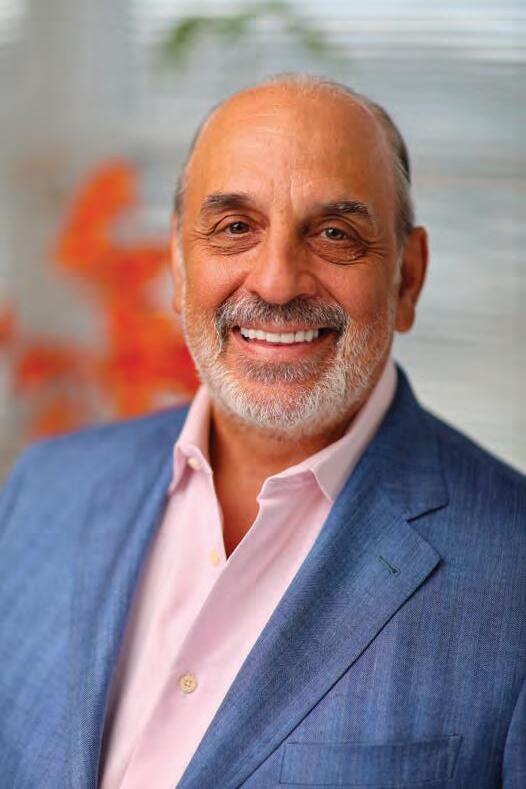
open and interactive setting like the collegiate athletic training setting that I was used to versus an examination room environment that many physical therapy clinics had at the time. Plus, the community outreach athletic training program.
OBM: When did you first know that Athletico would be successful and/ or expand beyond the initial clinic?
MK: When I started receiving direct referrals from the best physicians in Chicago along with patients referring patients to us, combined with the interest and demand we were creating with our athletic training outreach program.
OBM: What were your goals and/or values when starting the clinic? How have they evolved or stayed the same?
MK: Deliver differentiated care and customer service. Doing things with detail that positively impacts the patient’s entire experience. Relationships matter. Everything matters. Be willing to outwork anyone. I had to always continue to improve as a PT, as an athletic trainer, a manager, and a leader. No standing still, either [we are] getting better, or we are getting worse.
OBM: What are some of the challenges of expanding a company?
MK: Personally, leadership, business, and management skills. Scale and managing the business and financial operations. Surrounding yourself with good advisors and consultants (along with developing and building a great team) [is necessary].
OBM: How have you grown as a brand and stayed at the forefront of the field through expansion?
MK: We deliberated our growth for many years (20+), growing steadily but rather slowly. When we decided we could take
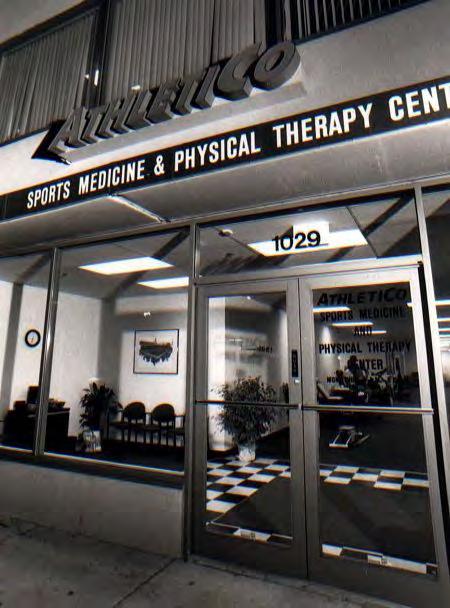
this business outside of Illinois, and successfully did, we started to think bigger. Our name and brand have been built by the team’s dedicated service and efforts since 1991.
OBM: What does it mean to you to be able to serve so many people in over 900 locations?
MK: All credit goes to the team for the day-in and day-out work and service they provide to patients, athletes, injured workers, etc. When I take a step back, it is sometimes hard to digest how far we have come since I opened in August 1991 with one employee to 10,000 employees in over 900 locations in 24+ states.
OBM: How has your role in the company changed over time?
MK: I was always more com-
fortable being part of the team and contributing than being CEO, but naturally, I had to assume that role and responsibilities. I stepped down as CEO in the summer of 2019 and have remained active as Executive Chairman since. Our CEO is Dan Guill.
OBM: What are your goals for the future of Athletico?
MK: Fully bounce back from the hit the industry and business took from COVID and begin growing again in the areas and communities we choose, all the while keeping the focus and energy on the customer and patients’ experience and providing a differentiated experience.
OBM: What’s one piece of advice you’d give to someone who wants to start their own business or pursue an entrepreneurial idea?
MK: Be prepared to be “on” 24/7 for a very long time. That [it] can be fun, and it can be exhausting and consuming.
OBM: How do you like spending your free time outside work?
MK: I enjoy being with my three daughters and family and extended family and staying connected to as many friends as possible. My hobbies include reading/learning, fitness, and golf. I would like to get back to photography, numismatics, and some learning or interest around wine and hospitality.
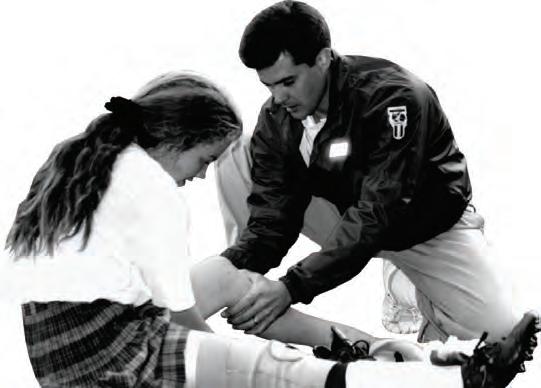
OBM: Is there anything else you’d like readers to know?
MK: I am very proud of what we have created at Athletico and know it would not have been possible without the contributions, work, and commitment of our great group of people.
This interview has been modified slightly for print. ■


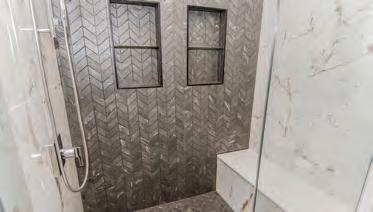




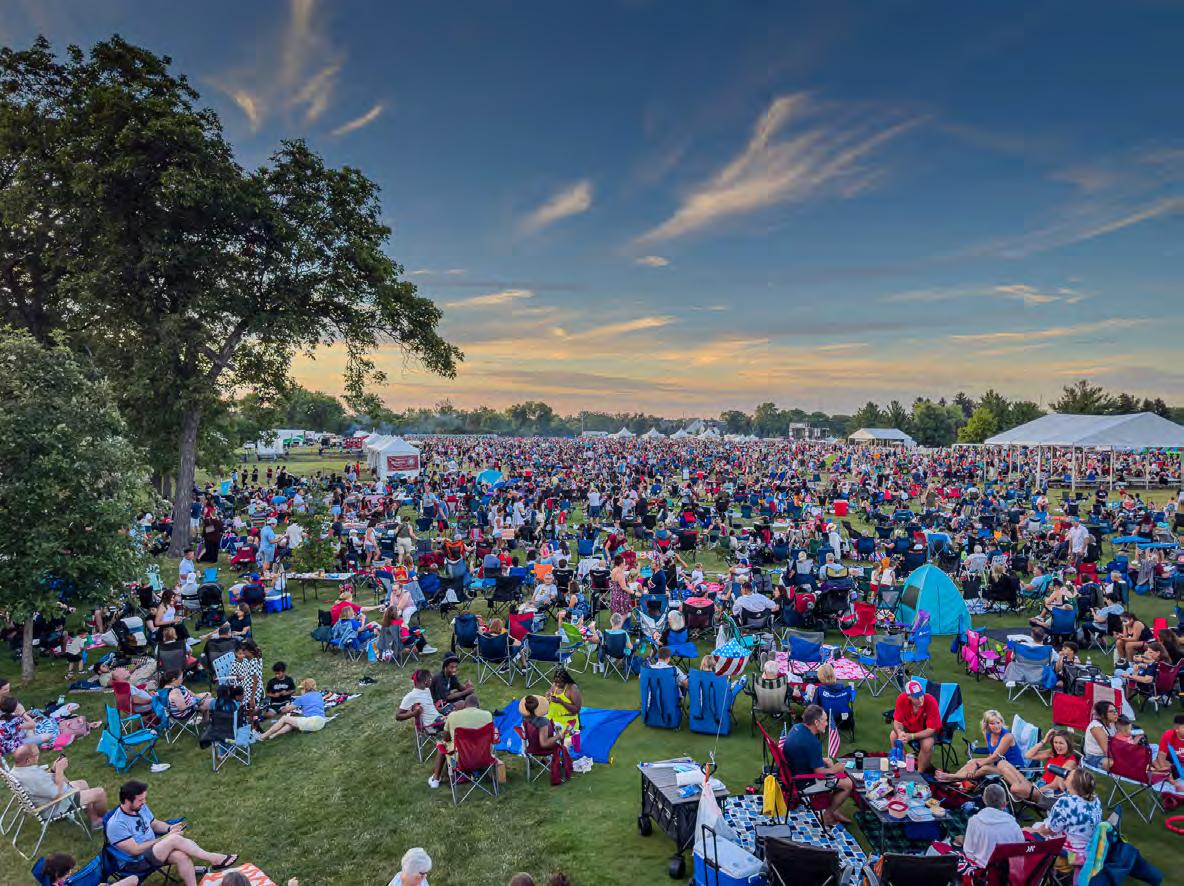
Every July 3rd, up to 40,000 individuals go to the Oak Brook Sports Core to enjoy Chicagoland’s best food, fun and fireworks at the annual Taste of Oak Brook. This spirited celebration of food, community and entertainment brings together local restaurants, food vendors and live music for an evening of delicious bites and great company.
A variety of local restaurants will be on hand selling “taste” portions of old and new favorites for patrons. An enlarged Alter Brewing Beer Garden returns with tasty ales to quench your thirst, and other adult beverages will be available at dedicated bars located throughout the event.
Children attending will enjoy free face painting, balloon animal makers and inflatable fun. Fearless, a Taylor Swift tribute band, will kick off the evening’s music followed by the highly popular returning headliner Sixteen Candles.
When dusk arrives, attendees will be treated to a stunning drone show that lights up the night sky! This cutting-edge entertainment blends technology and artistry and will feature twice as many drones as 2024, with 300 synchronized drones creating a mesmerizing display. The entertainment will be capped off by a vibrant 22+ minute fireworks show.
Taste Committee Chairman Trustee Michael Manzo shared “Last year more than 30,000 visitors attended the Taste of Oak Brook. We are one
of Chicagoland’s most anticipated events of the summer. Visitors really enjoy sampling the great food from area restaurants, live music from our popular headline bands and our exciting show in the sky. The highly popular drone and fireworks show is returning. It’s the perfect way to celebrate freedom and community in Oak Brook.”
Admission is free. For prepurchased parking as well as additional information on the Taste of Oak Brook, visit www.Oak-Brook.org/Taste
Whether you’re a foodie exploring new flavors or simply looking for a fun outing with family and friends, Taste of Oak Brook offers something for everyone. Don’t miss out on the tastiest event of the season! ■



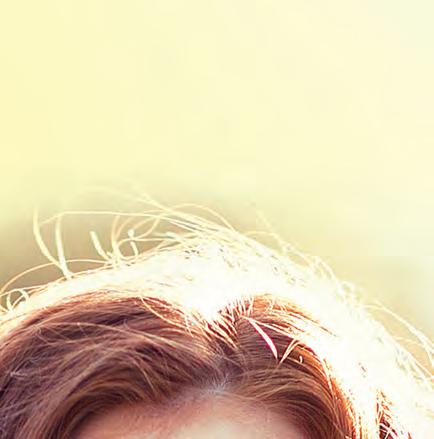











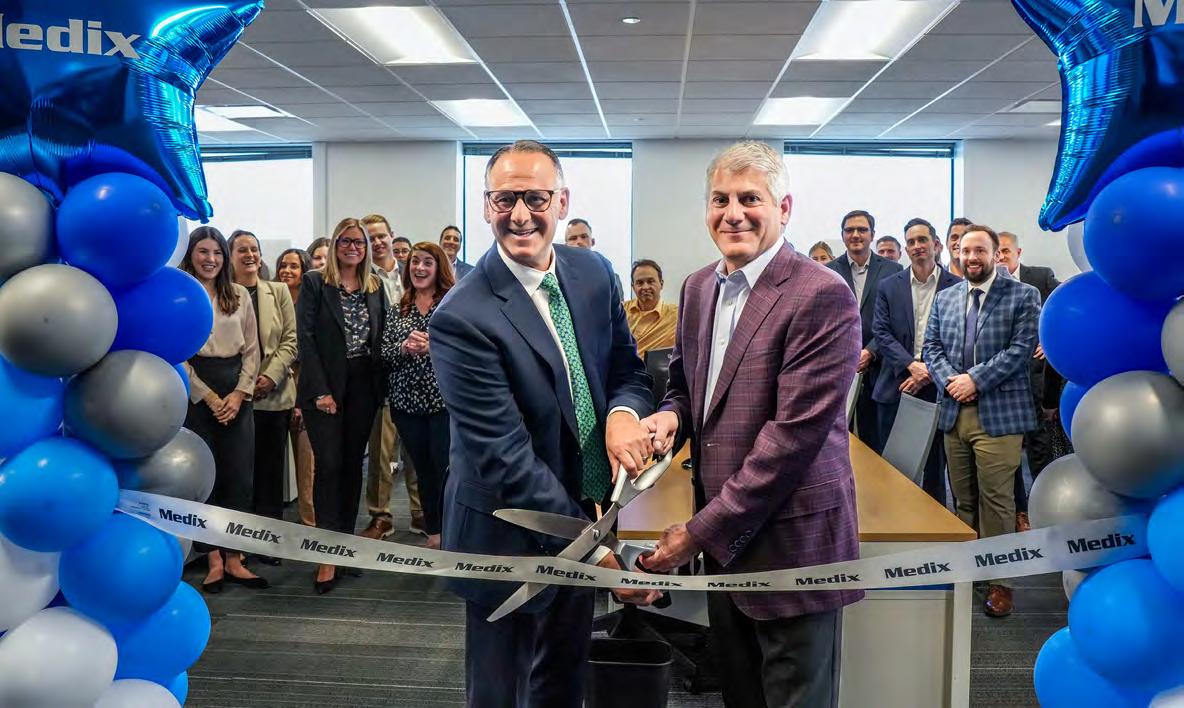
The Village of Oak Brook offers the best economic and business friendly conditions in the Chicagoland area and companies are taking note.
Companies cite a supportive and responsive local government, no municipal property taxes, no food and beverage taxes, low hotel taxes and sales tax almost 3% lower than competitors. Oak Brook has also made a strong investment in public safety and was recently voted one of the Top 10 safest suburbs in the United States.
Centrally located in the Chicagoland area, Oak Brook provides ideal access to highways like I-88, I-294, and I-55, ensuring efficient travel with quick connections to downtown, O’Hare, and Midway airports, allowing companies to quickly reach regional, national, and international markets.
Further, Oak Brook features featuring a skilled workforce, top-tier offices, and proximity to a vibrant, upscale community. A desirable mix of lush green space and luxurious amenities, creates a productive and inspiring setting . Oak Brook’s world-class shopping, dining, and entertainment scene enhances both work and lifestyle.
Recently, Medix Staffing Solutions, with 23 offices nationwide made the decision to relocate their corporate headquarters back to Oak Brook. Medix President & CEO Andrew Limouris shared, “It’s hard to believe that this past January, we celebrated 23 years since Medix was born right here in Oak Brook in a tiny 8x10 square foot office. From those humble beginnings, we’ve grown, relocated our headquarters downtown, expanded offices across the country, and now serve clients across nearly all 50 states. Over the years, we’ve been fortunate to receive recognition, including the
Inc. 5000, Crain’s Fast 50, Clearly Rated’s Best of Staffing Client, Talent, and Employee, SIA Largest Staffing Firms awards, and more, all testaments to our team’s hard work and unwavering commitment. Returning to where it all started feels like coming full circle. We’re incredibly excited to be back in Oak Brook, ready to embark on our next phase of growth and continue positively impacting lives.”
Medix joins Oak Brook’s impressive roster of corporate headquarters including Ace Hardware, Hub Group, Inland Real Estate, Chamberlain, Portillo’s, and TreeHouse Foods.
Oak Brook’s strong reputation as a business headquarters hub has endured since its inception and today Oak Brook continues to be an ideal choice for companies seeking growth and visibility in the Chicagoland market. ■
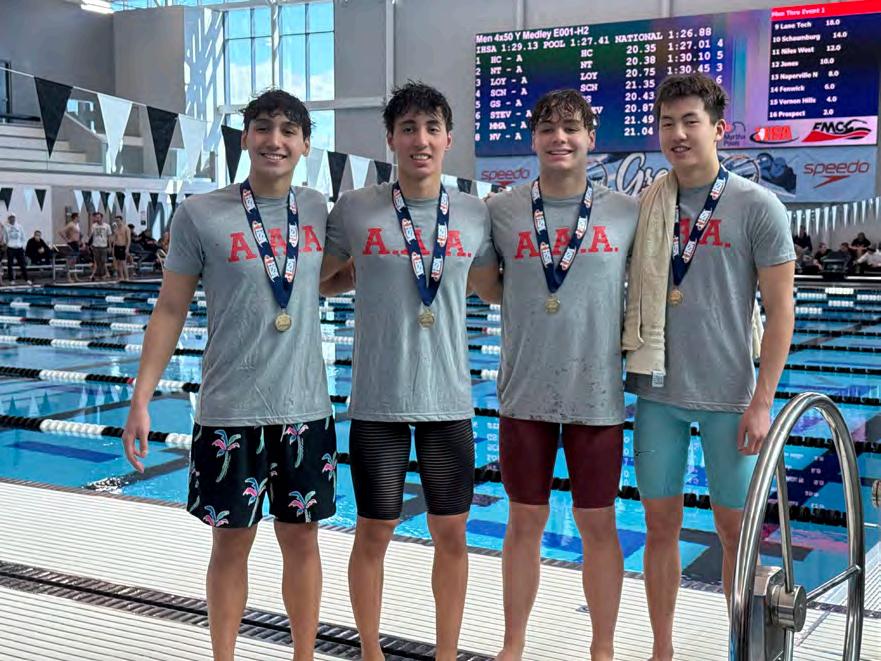
Hinsdale Central breaks national record at the state meet
BY JEFF VORVA
Henry Guo had his doubts. The Hinsdale Central senior swimmer and his pals were discussing the possibility of breaking a national record in the 200-yard medley relay event at the Illinois High School Association state meet.
Carmel High School in Indiana owned the mark of 1 minute 26.88 seconds, which it set in 2022. On February 28, the Red Devils were ready to hit the pool in the state preliminaries with the record in mind, even though Guo, a Penn commit, wasn’t convinced.
“I was a little apprehensive about going into this meet and breaking a national record,” he said. “It seemed like all the odds were stacked against us. Theoretically, it was possible, but
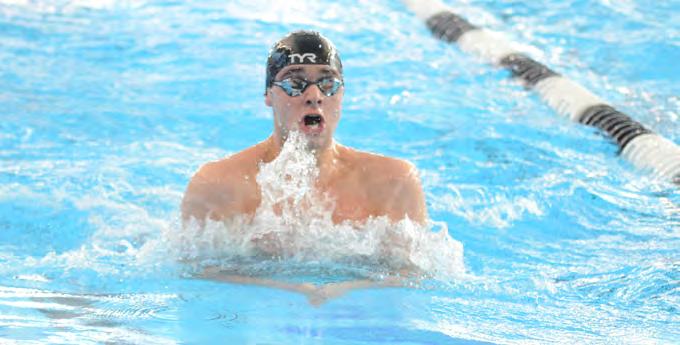
everyone would have to have an ideal swim.”
Guess what? Much to Guo’s pleasure, everybody DID have an ideal swim.
From sophomore Luke Vatev in the backstroke to senior Josh Bey in the breaststroke to Guo in the butterfly to junior Matthew Vatev in the freestyle – they all swam out of their minds, and the Red Devils clocked in at a speedy 1:26.75 at the FMC
Natatorium in Westmont.
It took Guo all of 21.53 seconds for him to change his mind. That was Luke Vatev’s time in the backstroke to lead things off.
“When Luke slammed his time, I was like, ‘Wow, we could actually do this.’’’ Guo said.
“Breaking the national record was kind of a goal time, and with that 50 back, going 21-mid, I was happy,” Luke Vatev said. “Then I watched Josh swim his leg, and I just had that feeling…we were flying. It was awesome.”
Bey swam a :24.04 in the breaststroke event. He hit the pool with a vengeance.
“It’s going to sound a lot more aggressive than it actually was, but I just wanted to go out there and kill everyone,” the Indiana recruit said. “I just had this mindset that I was going to go in there and just destroy and set the standard for the meet, and we were going to show everyone what Hinsdale Central is all about.”
Next up was Guo in the butterfly and he kept the momentum up with a :21.01.
Finally, Matthew Vatev, another Penn commit, had the task of bringing the record home, and his freestyle time of :20.17 clinched it.
“Once I saw my brother touch at :21.5, I just started jumping and going crazy,” Matthew said. “I was like, ‘holy crap,’ that was so fast. I really knew once he did his job, the entire thing was possible. When I saw Bey go, it was right where he needed to be. We were under the record at that point, and the chance was there. Henry went, and I was on the block and ready to go. My start was a little hesitant. But when I finished, I saw the board, and I wasn’t sure we got it because I didn’t know what the record was. I was looking up and processing it all. Then they came over and shook my hand, and I knew that we had it.
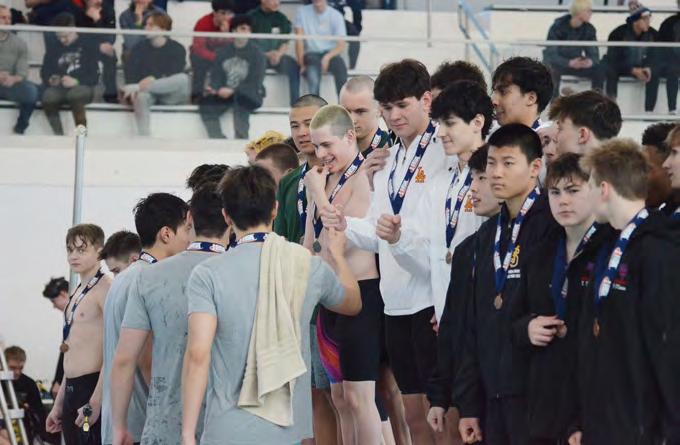
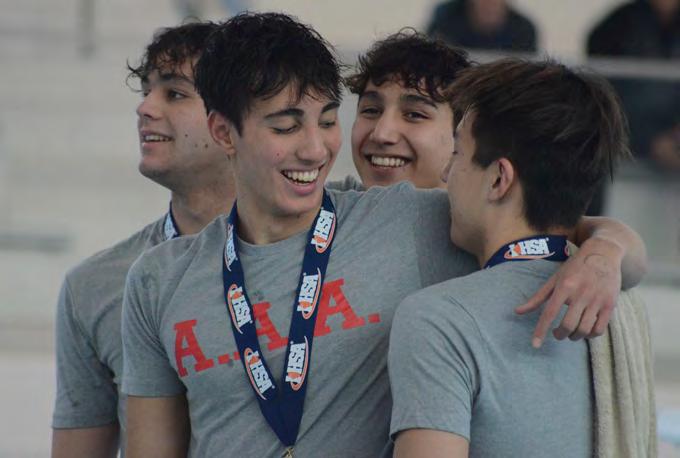
My gosh. It was pure excitement.”
Guo also celebrated an accomplishment he wasn’t sure could be done.
“After seeing that 1:26 pop up on the board, the feeling was just indescribable,” he said. “It was a mixture of just shock and excitement. I just couldn’t believe my eyes.”
The quartet hoped to break its own record in the championship on March 1 but fell short with a still-impressive 1:27.01. It was more than good enough for a state championship. The Red Devils won their third straight state championship and
21st overall with 338 points, miles ahead of runner-up Marmion Academy’s 190. It was coach Bob Barber’s fourth title and the eighth time under his watch that the Devils brought home a trophy.
Luke Vatev won the 100 back (:46.95) and 100 free (:43.57), and Bey won the 100 breast (:53.32) and 200 individual medley (1:43.96).
The 200 free relay team of Bey, Matthew Vatev, Brandon Suliga, and Frankie Adamo won with a 1:21.33, and the 400 free relay team of Guo, Noah Pelinkovic, Luke Vatev, and Adamo took care of business with a 2:59.38. ■

abilities. His plane, which flew the farthest, secured victory and foreshadowed his future success.
His passion for creation and mechanical understanding was evident in all areas of his life. He won a statewide art-science competition and then, to the surprise of many, declared his ambition to become a surgeon.
Driven by his ambition to pursue education in the United States, Byun’s family relocated to Southern California during his formative years. His early experiences in America were deeply influenced by his parents’ rich cultural heritage and the vibrant diversity of California. He was raised with a profound respect for education and an unwavering work ethic, values instilled by his
Your skin is most valuable to you and only you. Don’t take it for granted.
- DR. MICHAEL BYUN
father’s exemplary dedication and his mother’s intellectual curiosity.
HOW THE BYUN LIFT WAS CREATED Byun’s pursuit of excellence led him to Northwestern University, renowned for its intensely competitive plastic surgery program. He distinguished himself rapidly, rising to the top of his residency and securing the university’s inaugural interfrated plastic surgery fellowship. His exceptional performance earned
him the privilege of training under the esteemed ‘Holy Trinity’ of Northwestern Plastic Surgery: Dr. B. Herold ‘Hal’ Griffith, Dr. Peter McKinney, and Dr. Victor L. Lewis.
“After my 11 years spent at Northwestern for Medical School, I was able to form very close relationships with my professors. Shortly after starting independently, I inherited three of my professor’s caseloads. I hate to say it, but I didn’t like any of their long-term results and knew in my heart and mind that the traditional techniques were flawed.”
Byun recognized from the outset that true facial rejuvenation began with addressing the underlying muscle structure. He knew there had to be a more physiologically sound and effective approach to improve facial rejuvenation. Through extensive research and meticulous study, Byun developed his own facial rejuvenation technique, The Byun Lift – an approach to fix the problem by reverse-engineering the aging process, using an endoscope to see underneath the face. The detail and focus enable the restoration and preservation of one’s natural features. This method has consistently delivered proven, long-lasting results.
He emphasizes the fundamental role of gravity, stating, “Gravity affects all bodies, including the face. Over time, facial muscles descend.” His innovative approach focuses on restoring these muscles to their original midline positions, allowing for a natural realignment of facial features. This ‘reverse facelift’ technique, as Byun calls it, aims to reverse the effects of aging and/or correct prior surgical interventions. He advocates for this method to become the ‘new standard’ in cosmetic facial surgery.
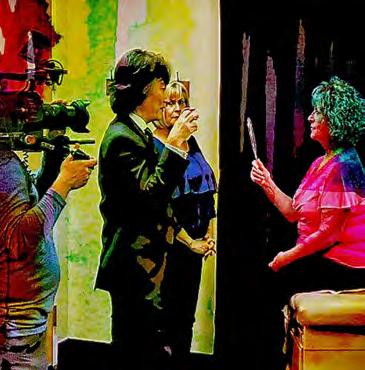
skin outward, widening the face. Your skin is uniquely yours and incredibly precious. It’s crucial not to underestimate its importance.
Byun’s philosophy is rooted in creating results that stand the test of time. His approach contrasts sharply with the quick-fix mentality that dominates the cosmetic surgery industry. Many surgeons promise immediate results but
fail to consider the long-term effects of repeated procedures.
Byun views the facial muscles as interlocking puzzle pieces. His technique focuses on precisely repositioning these muscles back into their original anatomical pockets. This restoration naturally contours the face, eliminating the need for excessive skin removal. The skin drapes smoothly by aligning the muscles along their natural convexity towards the midline, revealing beautifully restored muscle contours.
In some cases, previous procedures may have removed too much skin, which is essential for this natural draping process. Byun warns his patients of this through education. In cases where a patient has had multiple prior facelifts, it could end up that there’s not enough skin left to achieve an optimal outcome; you can’t just create new skin. Be wary of surgeons who essentially discarded valuable tissue – by cutting it away and pulling the remaining
What troubled me was the accelerated aging I observed in patients who had undergone traditional cosmetic procedures. The long-term effects of fat grafts, fillers, and skin-tightening devices were often detrimental; moreover, the crucial issue of sagging facial muscles was consistently overlooked.
– DR. MICHAEL BYUN
His extensive experience spans diverse patient demographics worldwide, including individuals from every continent. Through years of meticulous monitoring and personalized adjustments, he has consistently learned and refined his techniques with each patient. This method promotes natural, graceful aging, allowing patients to retain their inherent beauty. Byun’s singular technique draws patients globally, as no other surgeon offers this level of expertise.
Byun’s work reflects his Eastern and Western influences and his early bicultural household, giving him a unique perspective on beauty, balance, and harmony. As he continues to explore creative outlets, he still believes the principles of art (balance, proportion, and harmony) are deeply connected to plastic surgery.
Having a air for art and science,
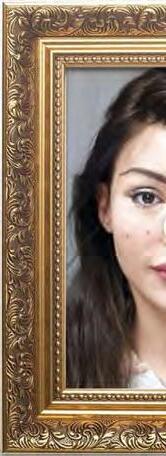
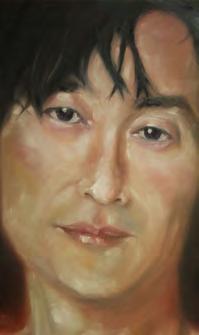
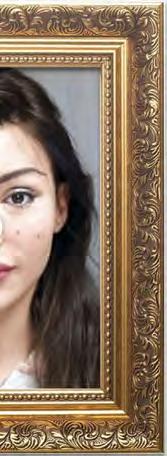





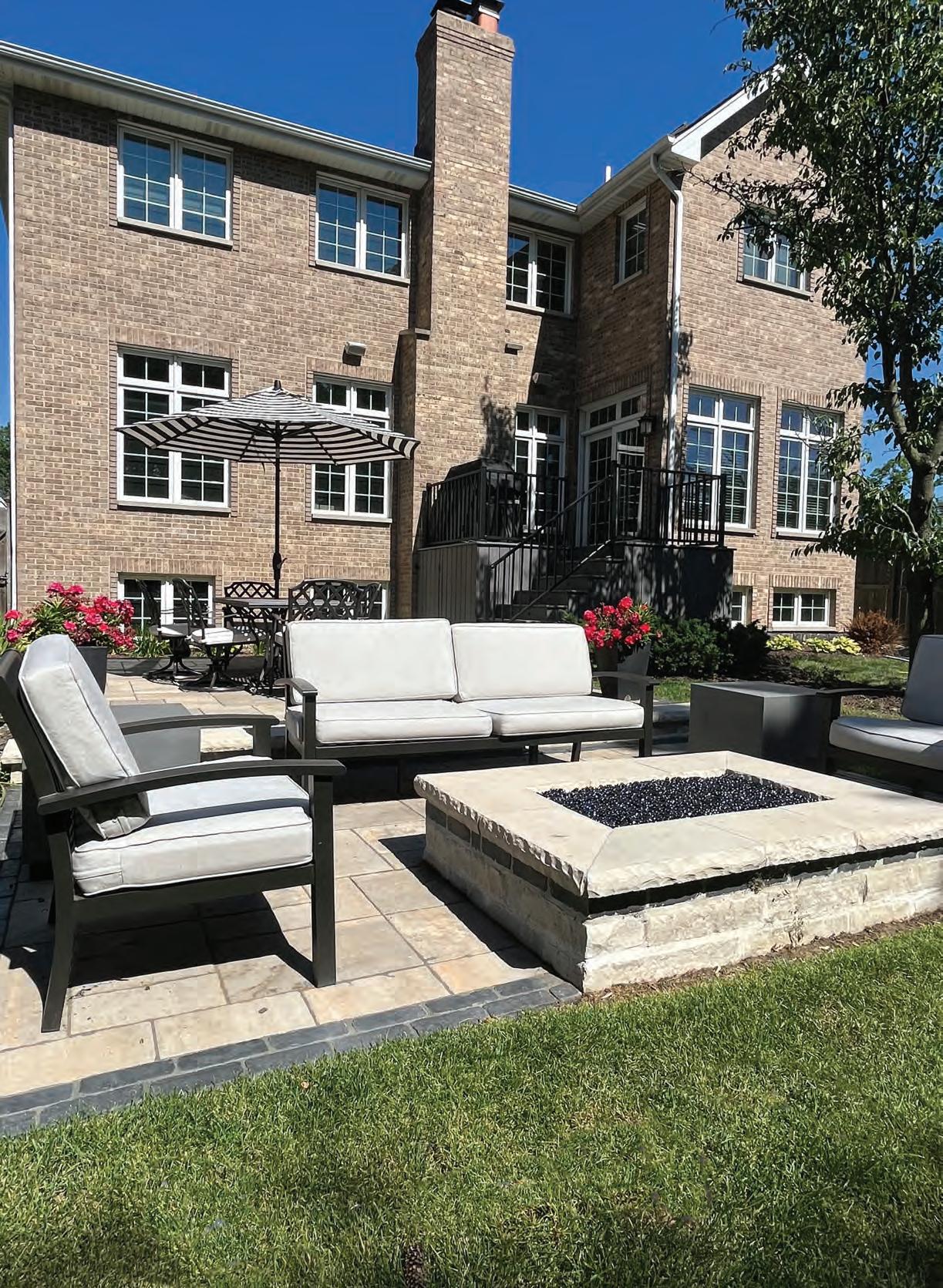


Medical training programs and practices in Illinois are on the cutting edge when it comes to considering how artificial intelligence (AI) can enhance patient care and physician functionality. For example, the University of Illinois at Urbana-Champaign’s Department of Bioengineering was the first to offer an AI in Medicine Certificate Program for healthcare professionals.
This six-week continuing education program provided physicians, medical students, and other clinicians with information about the latest in digital medicine and practical applications for it via case studies involving machine learning. Additionally, the course addressed ethical and legal considerations related to the use of AI in clinical settings.
Likewise, while University of Chicago (UChicago) medical faculty and students are not formally trained in the use of AI for clinical purposes, “there are frequent seminars, grand rounds, and journal clubs addressing AI’s role in medicine,” explained Dr. David Beiser, an emergency physician, clinical scientist and informaticist, and Associate Professor of Medicine at UChicago.
BY VALERIE HARDY
“Because the [AI in Medicine] field is still young, structured training programs are just beginning to emerge – but there’s strong interest and growing engagement at all levels,” Beiser added.
Fellow physician Dr. Alexander Pearson, who holds an MD, a PhD in statistics, and is an Associate Professor of Medicine specializing in hematology and oncology, is working to expand the machine learning and data science curriculum at UChicago’s Pritzker School of Medicine. He also runs the Center for Computational Medicine and Clinical Artificial Intelligence.
Pearson said that he is frequently asked when AI is going to arrive within the medical field, and his prognosis is that “it’s already here, and its capabilities are only increasing.”
An early use of AI in medicine is in mammography, with most mammograms in the United States having a “computer-assisted diagnostic component,” explained Pearson. He further noted how AI can help radiologists complete diagnostic tasks more cost-effectively, efficiently, and accurately.
Documentation is another area in which AI increases physician
efficiency and quality of patient care. Both Beiser and Pearson now use ambient notetaking tools, which use AI to automatically transcribe and summarize conversations between healthcare providers and their patients, allowing them to look their patients in the eye rather than at the notes on their computer screen.
According to Beiser, AI is best used in the medical field when it “offload[s] the mundane and repetitive aspects of clinical work, allowing physicians to focus more on higher-level decision making, big-picture thinking, and building stronger connections with our patients.”
Ironically, AI may offer more empathetic responses to patients than human doctors can. This is because in busy clinical settings, doctors may tend toward “accurate but rushed” communication with patients, unintentionally forgetting to respond with compassionate language, Pearson said, while “large language models never have to get home to their kids,” so they can allocate unlimited time toward acknowledging patients’ symptoms and emotions.
Medical trainees also have access to “large language models, with huge amounts of data at the elbow to
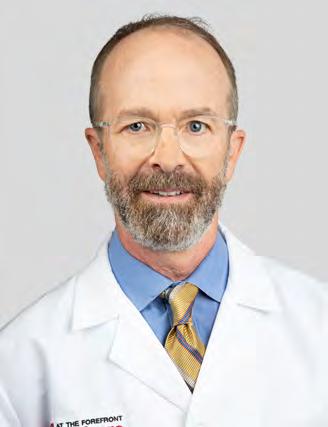
instantaneously answer medicalbased questions,” Pearson said, which he considers “invaluable.”
Even veteran practitioners lean on AI platforms “to provide decision
“It’s already here, and its capabilities are only increasing.”
- ALEXANDER PEARSON, MD, PHD, ON AI IN
support and stay current with emerging research,” Beiser noted.
These uses of AI in medicine, along with others such as grant and manuscript writing, have been correlated with decreased physician burnout, which leads to increased quality of care for patients.
However, there are still bugs in the system, and end users must be mindful of these. One concern is that medical professionals and trainees may become overly reliant on AI tools, Beiser said.
AI may also inadvertently “reinforce biases from data from
society,” Pearson said. Beiser echoed this potential for bias, explaining that “AI tools trained on non-representative data or deployed without oversight can amplify existing disparities in healthcare.”
To mitigate such bias, both Pearson and Beiser advocate that AI be used to augment, not replace, traditional medical practices. Beiser said, “The key is to…remain vigilant in how we implement and supervise its use in both clinical practice and training environments.”
While the incorporation of AI into medical treatment and training brings a mix of advantages and challenges, one thing is certain: “medicine in the future will look different than it looks now,” Pearson said, predicting that “the most successful physicians will be the ones who integrate technology into their realm of practice.” ■
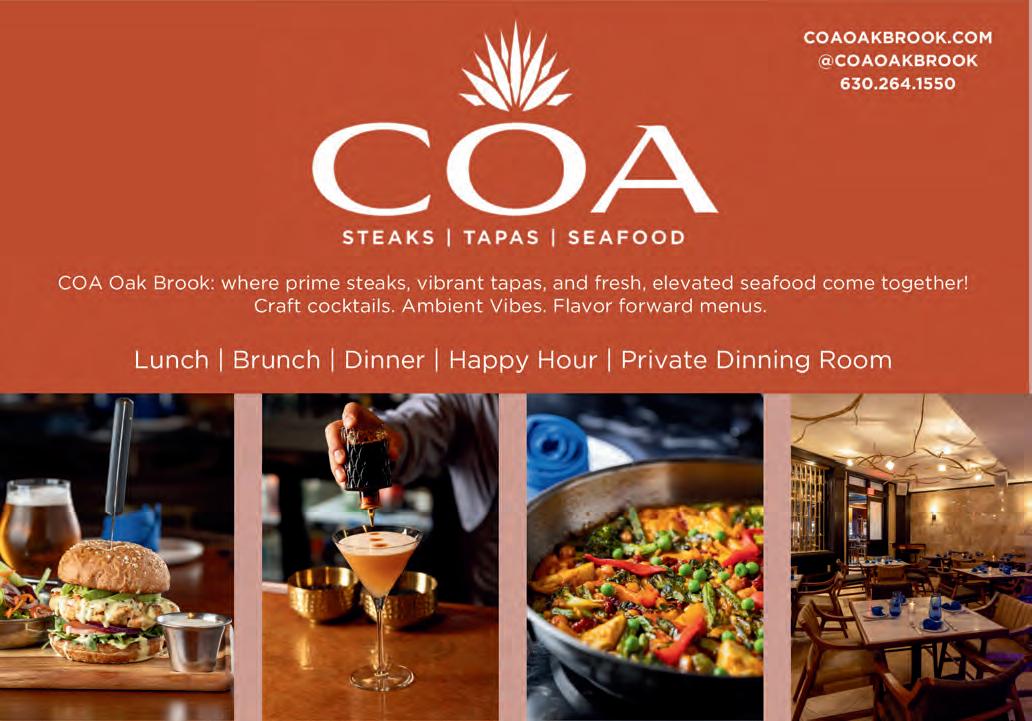
made possible by the powerful X-rays at the Advanced Photon Source (APS), a DOE Office of Science user facility at Argonne.
To develop these new protein sensors, the team used artificial intelligence. Their goal was to build proteins that could find and attach to small molecules—like methotrexate, a common cancer drug, or thyroxine, a hormone related to thyroid health. Once a protein finds one of these molecules, it sends out a signal, similar to how a COVID test changes color to show a positive result.
The APS was crucial in this process. After designing the proteins using computer models, the team used APS’s ultrabright X-rays to examine the actual shape of the proteins at the atomic level. This helped confirm that the designs worked in real life—not just in simulations.
“These X-rays help us see the exact structure of the proteins,” said Kay Perry, a scientist with the Northeastern Collaborative Access Team at the APS.
“It’s one of the best ways to make sure any computer predictions are accurate.”
“Smart” sensors are proteins that light up or block electrical signals whenever they detect certain molecules. These signals can then be measured easily, like flipping a switch when the right molecule is present. Previously, scientists needed to iteratively test through many trials when developing such a “smart” sensor. Baker’s work provides a pathway to faster and more accurate “smart” sensor design.
These sensors could one day be used at home to monitor health conditions like liver disease, cancer, or thyroid problems. Today’s tests often can’t tell the difference between similar molecules, but these new protein-based sensors are much more specific.
Beyond medicine, the team is also looking at ways to use the technology to detect pollutants like microplastics or harmful chemicals in the environment.
This work was supported by the DOE Office of Science. ■
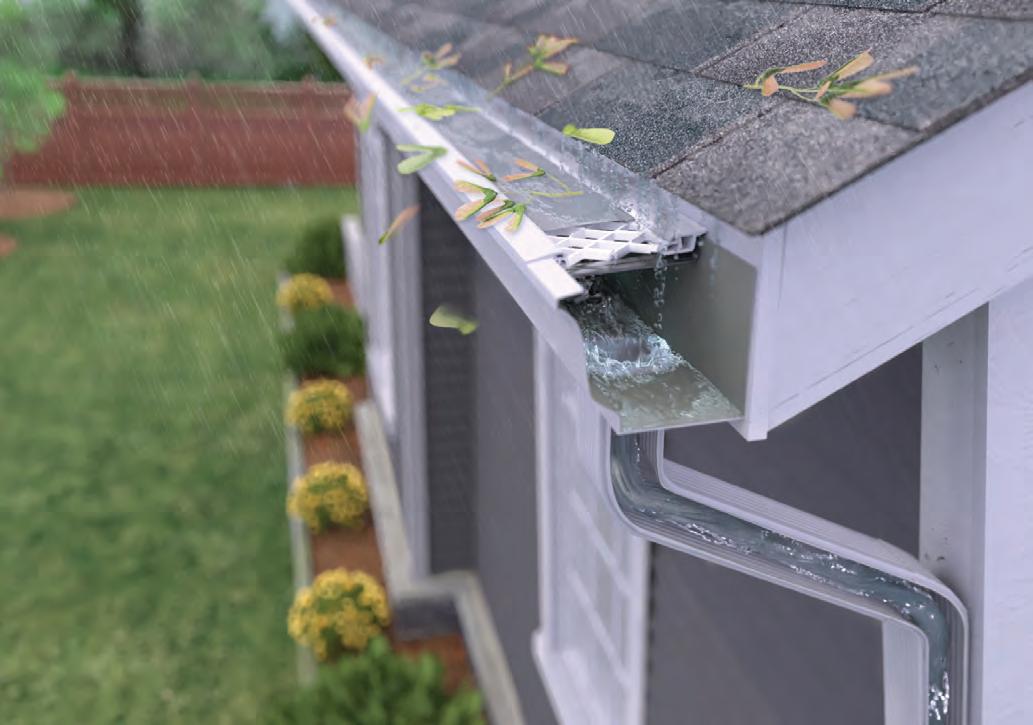



Welcome to NOTEWORTHY where we spotlight leaders in healthcare across various disciplines. In this issue, we celebrate the trailblazers who are not only advancing medical knowledge but also transforming patient care. With a commitment to innovation, compassion, and excellence, these distinguished professionals represent the heart of a dynamic industry dedicated to healing, discovery, and progress. Join Hinsdale Magazine Group as we explore their inspiring stories, exceptional achievements, and the latest advancements in the ever-evolving world of healthcare.
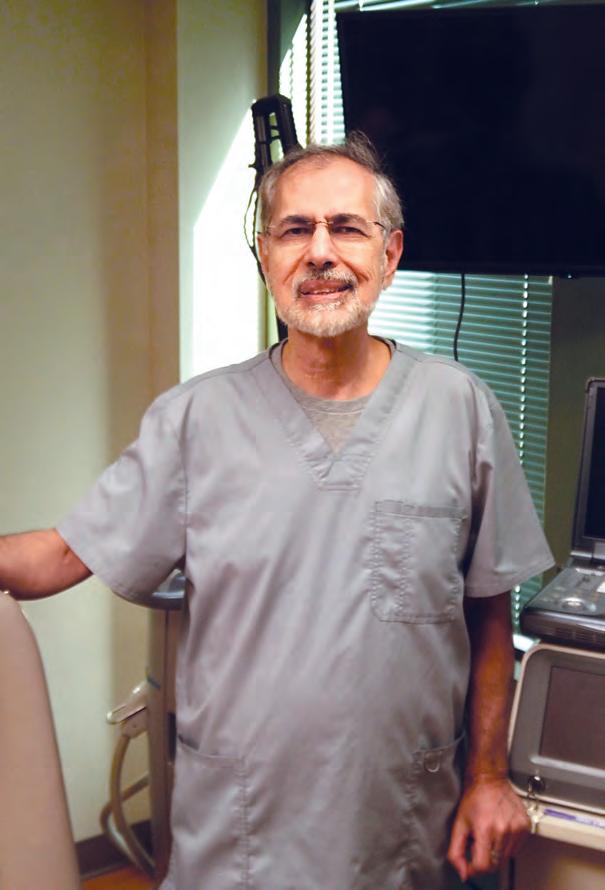
Oak Brook Magazine (OBM): People are increasingly concerned about the prevalence of varicose veins. How is your clinic addressing this issue through symptom awareness, treatment options, and prevention?
Jawdat Abboud, MD: At Charming Skin Vein Clinics, we specialize in diagnosing and treating varicose veins and related venous conditions with a patient-first mindset. Many people live with discomfort for too long without realizing help is available. Symptoms like aching, swelling, heaviness in the legs, and bulging blue or purple veins are signs that shouldn’t be ignored.
Our treatments are minimally invasive and include Endovenous Laser Treatment (EVLT), sclerotherapy, and, in more advanced cases, vein stripping and ligation. We use advanced diagnostic tools, like Doppler ultrasound, to ensure precision and effectiveness. We also emphasize education—helping patients understand how lifestyle changes, like staying active and wearing compression garments, can reduce symptoms or even prevent progression.
Our Oak Brook and Chicago locations offer convenience, and we work with many PPO insurances and Medicare to make treatment accessible. Ultimately, we want our patients not only to feel better but also to regain confidence in their appearance and mobility.
OBM: How do you distinguish your practice from other vein treatment providers in the area?
Dr. Abboud: With more than 30 years of medical experience, I bring a deep understanding of both the medical and cosmetic aspects of vein care. At Charming Skin Vein Clinics, we combine clinical expertise with the latest technology to deliver customized care. Our focus is always on the individual patient, and we strive to make treatment as effective and comfortable as possible. That personal approach, paired with our clinical capabilities, truly sets us apart.
OBM: What are the most common symptoms of varicose veins, and when should someone consider seeing a doctor?
Dr. Abboud: The most common symptoms include visibly twisted or bulging veins, especially on the legs, aching or heavy legs (often worse after standing or sitting for long periods), and swelling in the ankles or feet. Some patients experience burning, throbbing, cramping (especially at night), or itching around the affected area. In more advanced cases, the skin may become discolored, dry, or irritated.
You should seek medical care if you notice worsening pain, swelling, or skin changes—especially if ulcers or bleeding occur. Early intervention can prevent complications like blood clots or skin breakdown, and timely care significantly improves both comfort and outcomes.
Charming Skin Vein Clinics
2425 W 22nd St., Suite 103, Oak Brook, Illinois 630-974-1400 charmingskin.com
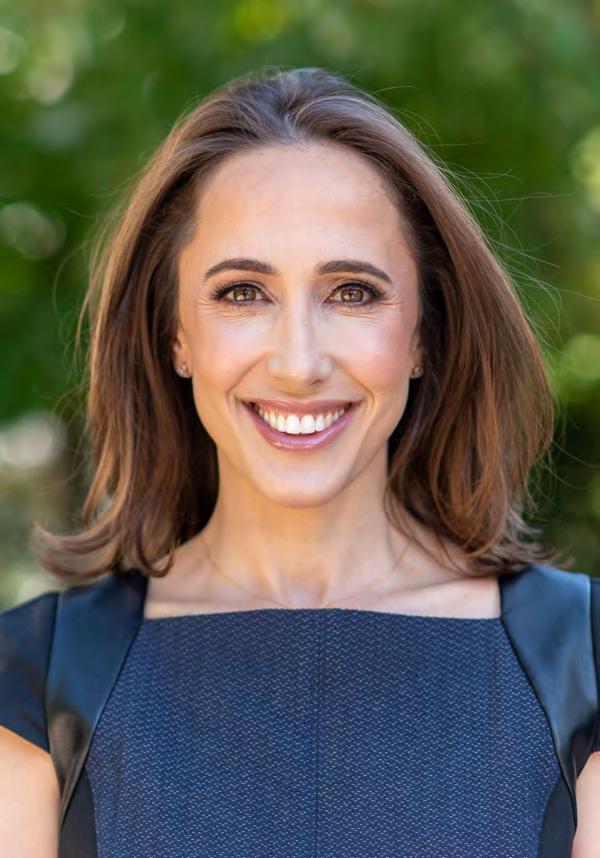
Oak Brook Magazine (OBM): Who were your mentors and how did they influence your current practice?
Dr. Rachel Bognet: I’ve been very fortunate to have worked with many wonderful physicians along the way. From a very young age, I was enamored by my pediatrician, who could make even the sickest child laugh with his comedic routines. Although, it was a summer job in college and volunteer work at the AAD summer camp for children with severe skin conditions that started my love for dermatology. My mentor in residency was most influential in how I practice. He had an unwavering dedication to teaching the basics and a deep understanding of clinicopathologic correlation. This proved vital in how I approach every patient, with a commitment to fixing even the most challenging cases. A dedication to lifelong learning is crucial to being a trusted and compassionate physician.
OBM: How do you stay passionate about medicine, especially after years of practice?
Dr. Bognet: Luckily, this is not difficult as Dr. Steil and I are constantly eager to learn about new technologies and emerging treatments. The plethora of safe and effective medicines we can now offer patients with severe eczema, psoriasis, hair loss, and acne is astounding. When I graduated residency, many of these were not created or an option yet and it has transformed how we can care for patients. Improving patient’s lives and restoring their confidence through groundbreaking medicines and cosmetic treatments is extremely rewarding.
OBM: What makes your practice successful?
Dr. Bognet: Building strong relationships with our patients is at the core of our success. Open and honest dialogue about their medical or cosmetic concerns allows patients to feel at ease. Listening and offering options without judgement or coercion is the foundation of trust in any relationship.
OBM: How do you see the role of precision medicine impacting dermatology in the coming years?
Dr. Bognet: Personalized medicine is already here and changes are rapidly coming due to advances in technology. We now have genomic testing available on skin cancer tissue to better guide the need for immunotherapy and radiation. Genetic testing is also allowing physicians to know which type of medication will be most effective for patients without the antiquted “trial and error” method. Better outcomes with minimal side effects is always the goal.
OBM: If you weren’t a doctor, what would you have wanted to be?
Dr. Bognet: That’s a tough question because I truly love what I do! I suppose when I’m too old to do surgery anymore, I would venture into home remodeling more. I’ve always loved old homes and restoring beauty and balance has always been a passion.
CSC Steil Dermatology
125 W 2nd St, Hinsdale, Illinois and 5157 Main St, 205, Downers Grove, Illinois
630-455-0045
cscdermatology.com
Oak Brook Magazine (OBM): What distinguishes you from other surgeons?
Dr. Michael Byun: I think it’s my understanding of facial anatomy as living tissues in layers. After graduating from Northwestern University Medical School and completing my Plastic Surgery fellowship, for which I was the inaugural fellow of integrated, combined seven year program, I developed a distinct surgical technique, The Byun Lift. Patients who align with my philosophy and seek my specialized skills experience exceptional outcomes. I believe I have a unique understanding of facial anatomy and meticulous surgical direction.
OBM: What is your philosophy, and how did this lead to The Byun Lift technique?
Dr. Byun: I was dissatisfied with the unnatural results of traditional facelift techniques, which often involved skin excision – thus leading to a stretched mouth and fat grafting – resulting in a round, stuffed face. For these reasons, I began exploring alternative approaches as a fellow some 25 years ago. My artistic background provided the dexterity to explore the role of facial muscles in aging. Discovering muscle descent as a key contributor, I developed The Byun Lift.
OBM: What is The Byun Lift?
Dr. Byun: The Byun Lift restores a natural, youthful look by focusing on muscle repair and tissue preservation, addressing both natural aging and/or complications from previous cosmetic procedure results. Unlike the conventional approach, where 99% of surgeons lift facial skin and tissues laterally towards the ears, The Byun Lift technique repositions the muscles upward and inward towards the midline of the face by use of an endoscope. This precise repositioning returns the muscles to their original, pre-aging location, providing a physiologically accurate and superior correction. This method not only lifts but also restores the underlying structures in layers, leading to more natural and long-lasting results. Patients often request The Byun Lift to recapture their youthful appearance, addressing both natural aging and the negative side effects of prior cosmetic procedures.
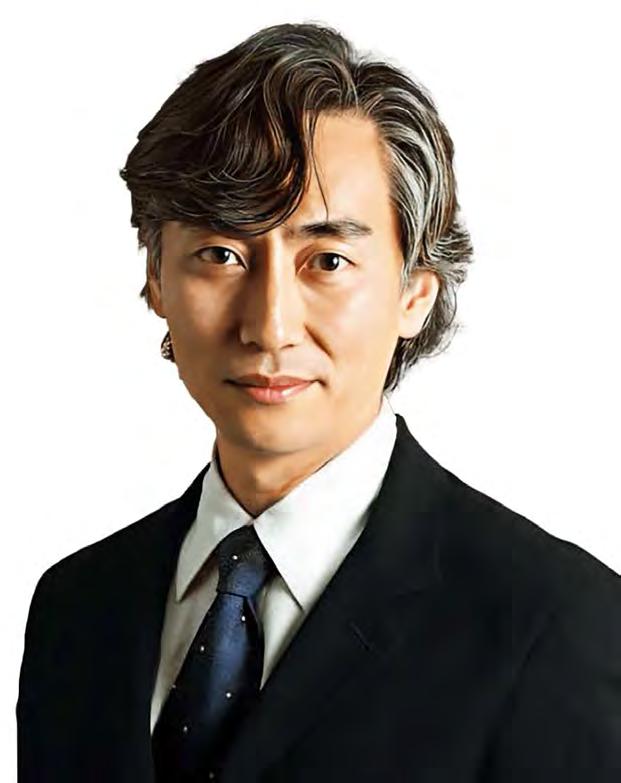
OBM: Can you help patients with problems or complications resulting from other cosmetic procedures or previous facelifts?
Dr. Byun: My specialization, rooted in trauma and pediatric reconstructive surgery, equips me with advanced skills in tissue repair by use of an endoscope. Achieving a natural, attractive correction to reverse what has already been done is contingent on the patient’s existing condition. I offer thorough consultations to educate and guide individuals through their options.
Chicago Cosmetic Surgery 1775 Walters Ave.
Northbrook, Illinois (847) 513-6899 chicagocosmeticsurgery.com

Oak Brook Magazine (OBM): Was there a specific moment or experience that confirmed you wanted to become an orthopedic surgeon?
Dr. Justin LaReau, MD: During my training at University of Michigan Medical School, I assisted in a complex joint reconstruction case. Seeing the patient’s ability to regain mobility and quality of life after surgery had a profound impact on me. It confirmed that orthopedic surgery was the right path for me — the ability to help people move again is incredibly rewarding.
OBM: How do you build trust with your patients?
Dr. LaReau: Trust comes from open communication and setting realistic expectations. I take the time to understand each patient’s concerns and goals. Explaining the procedure, recovery timeline, and potential risks allows patients to feel more comfortable and involved in their care plan.
OBM: What role do new surgical techniques play in your practice?
Dr. LaReau: Minimally invasive and roboticassisted procedures have been game-changers. Techniques like anterior hip replacement and MAKO-assisted knee replacement may allow for greater precision, less trauma to the tissue, and faster recovery times. These advancements have significantly improved patient outcomes in my practice.
OBM: What do you think is the most important thing a doctor can do to improve patient outcomes?
Dr. LaReau: Individualized care is key. Every patient’s body and lifestyle are different, so I create a treatment plan tailored to their needs. Staying ahead of surgical advancements and using minimally invasive techniques also improves outcomes and reduces recovery times.
OBM: How do you handle the emotional side of patient care, especially when outcomes are uncertain?
Dr. LaReau: Empathy is crucial. Sometimes recovery is slower than expected or complications arise, and patients feel discouraged. I make sure they know that setbacks are part of the process and that I’m there to support them every step of the way.
OBM: Have you ever thought about switching careers, or have you always known this was your calling?
Dr. LaReau: Orthopedic surgery still feels right for me. I am grateful for the opportunity to help patients regain mobility and improve their quality of life is incredibly fulfilling.
Hinsdale Orthopaedics
550 West Ogden Avenue, Hinsdale, Illinois
630-323-6116
hinsdale-orthopaedics.com
Oak Brook Magazine (OBM): How did you decide on your area of specialization?
Dr. Malhotra: I was initially drawn to dermatology because of my own experiences with severe acne and precancerous moles—challenges that allowed me to deeply relate to my patients’ concerns. What ultimately solidified my passion for the field was its unique blend of medical, surgical, and cosmetic care. The skin is a powerful reflection of overall health, and I find great fulfillment in helping patients not only achieve healthier skin but also regain their confidence.
OBM: How do you approach conversations with your patients?
Dr. Malhotra: I approach every patient conversation with empathy, openness, and a genuine desire to understand their concerns. Whether it’s a medical issue or a cosmetic goal, I believe in creating a safe space where patients feel heard and respected. I take the time to listen carefully, explain diagnoses and treatment options clearly, and involve patients in the decision-making process. My goal is to build trust and ensure that every patient leaves feeling informed, supported, and empowered in their care.
OBM: How has technology changed the way you practice medicine?
Dr. Malhotra: Technology has transformed dermatology in incredible ways—from how we diagnose and treat skin conditions to how we connect with patients. Tools like digital dermoscopy, AI-assisted skin analysis, and advanced laser technologies have elevated both the precision and outcomes of care. On the cosmetic side, we now have more refined, non-invasive options than ever before, which means better results with less downtime. Treatments such as Sofwave, Fraxel, Diamond Glow medical facials are just a few of the amazing things we offer.
OBM: How do you stay current with the latest medical research and treatments?
Dr. Malhotra: Staying up to date is essential in a constantly evolving field like dermatology. I regularly attend national conferences, participate in continuing medical education (CME) courses, and stay engaged with leading dermatology journals. I’m also part of professional networks and societies that provide access to the latest clinical guidelines, research, and treatment innovations. Whether it’s a breakthrough in biologics for skin disease or a new cosmetic technique/treatment, I’m always looking to integrate the most effective, evidence-based approaches into my practice to provide the highest standard of care for my patients.
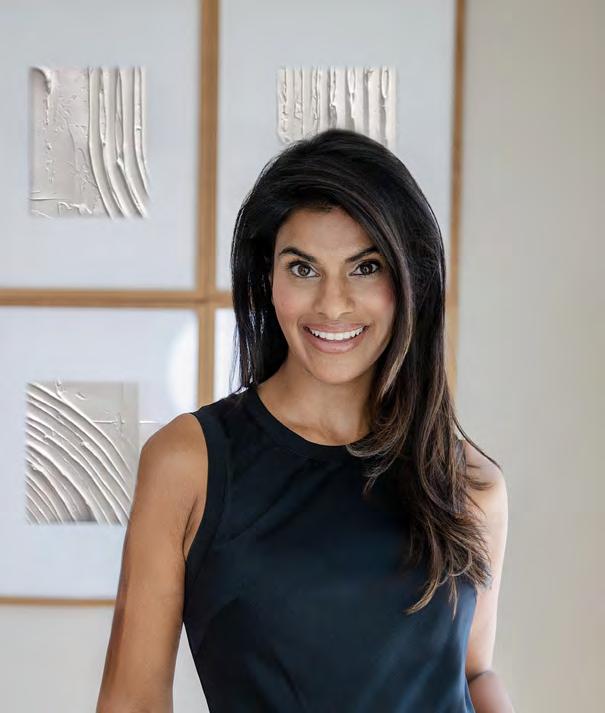
OBM: What’s the one thing you wish patients understood about the medical process?
Dr. Malhotra: I wish more patients understood that healing—whether medical or cosmetic—is often a process, not an instant fix. We live in a world of quick results, but dermatology, in particular, can require patience and consistency. Whether we’re treating acne, managing a chronic skin condition, or working toward aesthetic goals, meaningful results take time and collaboration. I always encourage open communication and realistic expectations, because when patients feel informed and involved, the journey becomes much more rewarding—for both of us.
OBM: How do you maintain a healthy work-life balance?
Dr. Malhotra: It’s definitely a juggling act, but I’ve learned to prioritize the things that recharge me. Running around outside with my two little boys, cheering them on at their games, playing tennis with my husband, or squeezing in a workout (and a good laugh) with my girlfriends—those moments keep me centered. Balance isn’t always perfect, but staying active, connected, and occasionally escaping with a good book or trip helps me show up as my best self, both in the clinic and at home.
SKN Institute
105 S York St # 500, Elmhurst, Illinois 630-349-3040 sknin.com
Oak Brook Magazine (OBM): What inspired you to pursue dermatology and establish CSC Dermatology?
Dr. Christina Steil: During my medical internship, I was caring for a complicated patient with unusual skin lesions. The dermatology team was called in and witnessing the attending dermatologist diagnose the patient at the bedside was a pivotal moment that inspired me to pursue a career in dermatology. I was fascinated by how the skin provides insight into the health of our body. My other passion was technology and its potential to enhance patient care. I established my own practice to have the flexibility to implement the latest technologies in patient care.
OBM: Could you elaborate on your areas of specialization within dermatology?
Dr. Steil: I specialize in both medical and cosmetic dermatology. I began my practice in 2000 with a focus on medical dermatology, aiming to help people achieve better health. Early in my career, I noticed a significant number of patients with sun-damaged skin. These were individuals who enjoyed outdoor activities but at the cost of their skin’s health and appearance. As a result, my practice in medical dermatology naturally expanded to include helping patients restore the health and appearance of their sun-damaged skin. Within a few years of starting CSC Dermatology in 2002, I began adopting new technologies and offering procedures to achieve this goal. CSC Dermatology became known for being the first in the area to offer many treatments. I was one of the first to train on using the injectable Sculptra ™, and I was fortunate to be trained by the physician who developed the technology.
We were also the first in the area to offer medical Photodynamic Therapy (PDT) for treating pre-skin cancers, known as actinic keratosis. I was grateful to treat an elderly man with severe sun damage using PDT, which helped reduce and slow the progression of his skin cancers. Additionally, we were the first to offer lasers to treat acne as an alternative to traditional medications such as oral antibiotics and isotretinoin.
For me, the practice of cosmetic dermatology and the use of lasers to treat sun-damaged skin is a continuation of the medical treatment of sun-damaged skin, pre-skin
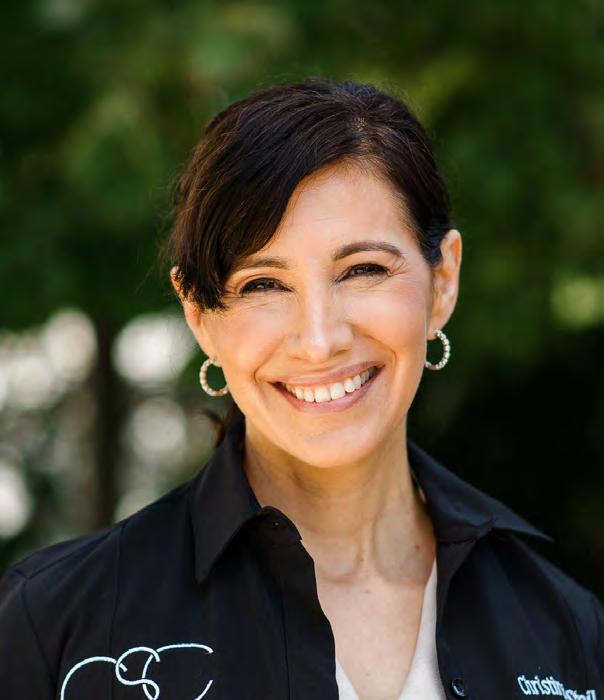
cancers, and skin cancer. I ensure that all patients who receive a skin examination and have photodamaged skin are educated on their options to restore their skin’s health and function. I inform them that we have lasers that can delay the aging of their skin and make them aware of published studies showing that certain lasers we use to improve the skin’s appearance can also reduce the risk of non-melanoma skin cancers.
OBM: What innovative treatments or technologies have you recently incorporated into your practice?
Dr. Steil: We are so excited about our newest device: the BBL® HEROic™ by Sciton. We have been offering BBL Fotofacials for years to prevent photoaging. The HEROic™ technology brings AI to the treatment room, making our treatments more comfortable, effective, efficient, and safer for our patients.
CSC Steil Dermatology
125 W 2nd St, Hinsdale, Illinois and 5157 Main St, 205, Downers Grove, Illinois
630-455-0045
cscdermatology.com
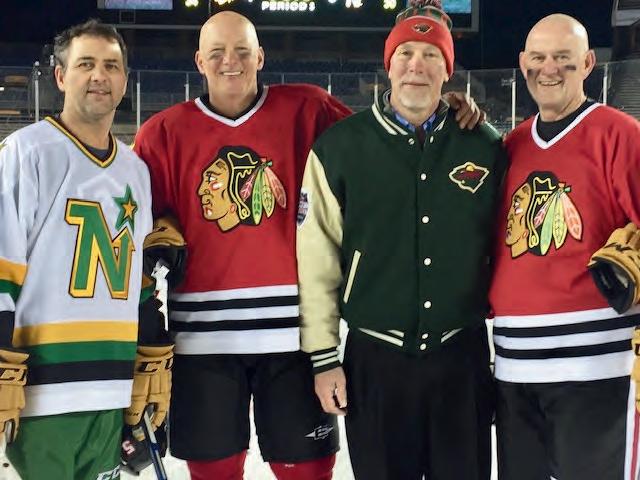
afternoon, which was great because we played a 4:00 p.m. game, but it was on tape delay, so nobody in the U.S. watched it in real time. The only people who knew we won were either Canadians, residents of Lake Placid, broadcasters who aired the game or people who had listened to it live on the radio. I don’t know how many people had planned to watch it either because we had lost 10-1 to the Soviets at Madison Square Garden just ten days before we faced them in the Olympics. Most people don’t want to watch a car crash in real time (O’Callahan laughed). But after we won that afternoon, the networks were saying things like, ‘We’re not going to tell you what happened in Lake Placid this afternoon, but be sure you don’t miss it tonight at 8!’
DO YOU REMEMBER THAT MOMENT WELL?
Yes! I’ll never forget it. The stadium was absolutely crazy! People on the street outside were going nuts! The team was all staying in the Olympic Village, but after we played, the hotel where our parents were staying threw us a big party. They put together a few conference rooms, and we had dinner while we watched the game with our families. It was such an amazing night!
BEFORE THE GAME AGAINST THE SOVIETS, COACH BROOKS TOLD THE TEAM, ‘THIS IS WAY MORE THAN A HOCKEY GAME.’ WHAT DO YOU THINK HE REALLY MEANT?
There really was so much more to it than hockey. The country had been through a lot of turmoil in the decades before that game. Most of the guys on that team were born in the 50s. Many of our fathers had fought in the Korean War and were very proud Americans. A generation gap developed in the 60s - an era of racial and social unrest, Vietnam,
Kennedy getting shot, draft dodging, etc. The country was very disconnected. Then we showed up in Lake Placid in 1980, and for two weeks, we played every other night. The momentum built up, and for the first time in a long time, everyone was very proud of the USA again. When we beat the Russians, it really brought the country – and the generations- back together.
WAS THE FINLAND GAME – THE FINAL HOCKEY GAME OF THE 1980 OLYMPICS IN WHICH TEAM USA CAPTURED THE GOLD – AS HARD?
Put it this way, the practice we played after we won the game against the Soviets but before we played Finland was the hardest one we ever had. Coach Brooks never dialed it down. As a matter of fact, it was the opposite. He pushed us so hard that we were like, ‘What is he trying to do? Kill us?’ That’s when he told us, ‘Do you think the Fins are going to lie down and give you this game? You’ve played six games as the underdog. Now you’re the favorite. The world is watching you, and everybody is waiting for you to lose. And if you do, you will take it to your grave!’
He was right. The Fins were a phenomenal team. The last period of that game, to our credit and Coach Brooks’, was probably the best 20 minutes of play in our year together as a team. We were down 2-1 going into the third period, but the Fins barely touched the puck in that last period. We beat Finland 4-2 for the gold!
HOW DO YOU THINK BROOKS’ STYLE OF COACHING AFFECTED THE OLYMPIC VICTORY?
Brooks knew his players well. He had coached most of them at some time before he assembled his Olympic team. He reminded all of us daily that he expected top effort every day. ‘Show up one day and give me 95% and you’ll make my job easy because I’ll get rid of you,’ he always told us. He constantly pushed us and that made us push each other.
I loved playing hockey in high school, and my team at Boston University (BU) won the NCAA tournament. That led to my spot on the Olympic team. While it was the honor of a lifetime, I always knew there would be life after hockey. Even when I was at BU and got drafted by The Blackhawks, the first thing I thought was, ‘If I play in Chicago, maybe I could learn how to trade commodities.’ So, playing hockey got me to where I eventually wanted to be. I now own an asset management firm.
We didn’t really do anything this year to celebrate, but we get together from time to time, and we’re all still close. Our first big reunion was in 2000. I talk to [Mike] Eruzione the most because we’re both from Boston and went to BU together, and now we both live in Florida. I talk to [Rob] McClanahan probably second most. But we’re hockey guys, so we’re all tight. Even Ralph [Cox] and Jack [Hughes], the last two guys who were cut from the roster right before The Olympics, are always included when we meet. We’ll probably do something for the 50th anniversary. ■
BY ANNA HUGHES
Nicknamed “America’s Hometown,” Cooperstown is more than just a small village in Central New York: It’s a rite of passage for young baseball players across the country. Home to the National Baseball Hall of Fame and one of the most prestigious youth tournaments in the sport, Cooperstown is a mecca for baseball fans and future professional hopefuls. Every summer, thousands of 12-year-old athletes have the chance to showcase their game on one of Cooperstown’s two pristine venues while making memories that last long after their tournament week is over. For many, it marks the peak of their youth careers—and the start of something even bigger.
Susie and Bill Howe’s summers are consumed by baseball, but that’s the way the western suburbs residents like it. Their three sons—Will (15), Andrew (13), and Jake (12)—all play, meaning their calendars are packed with practices and games, along with lots of driving and lots of laundry.
“Last year, I remember…with all three playing, April started, and there were 40 days straight that we had games,” Susie laughed.
The highlight of their recent baseball summers has been trips to Cooperstown. Both Will and Andrew
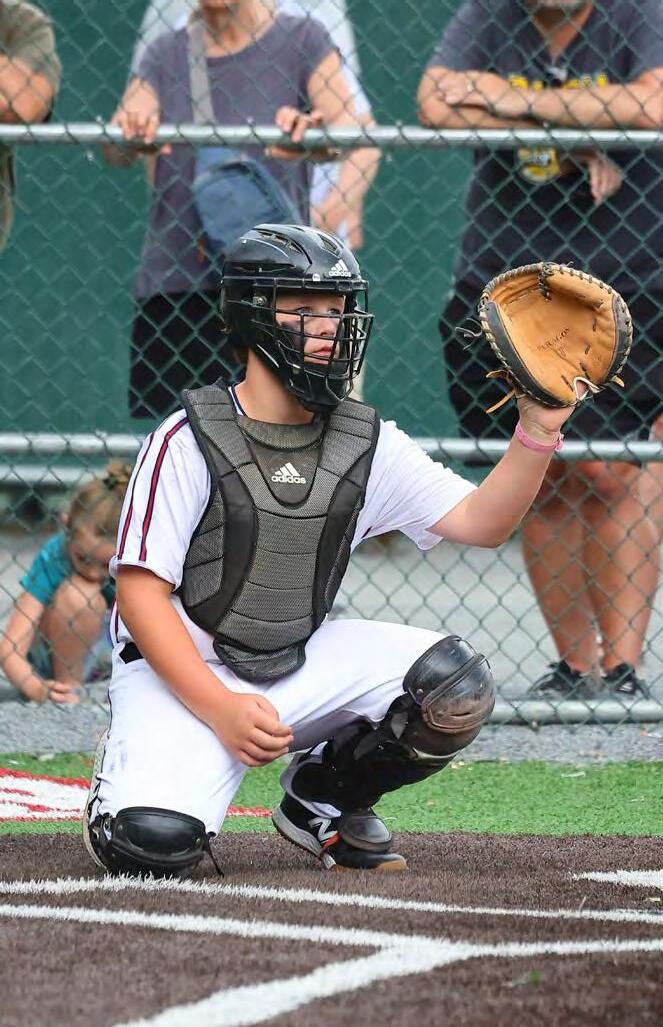
have played in the 12U tournament, during 2022 and 2024, respectively. This summer, it’s Jake’s turn. He’s been counting down since their first visit three years ago.
“The first time we went, nobody had any idea what to expect,” Susie said. “You feel like you’re fundraising, and you’re prepping for this trip, and you’re driving 14 hours, and you get there, and after a few days, you’re like, it’s just really as magical as they say.”
Teams apply to play at Cooperstown over a year in advance and fundraise to help cover the costs, which
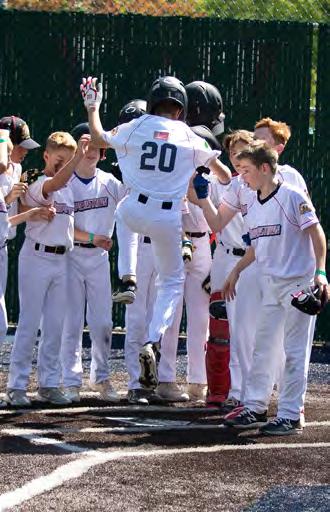
include the famous bunkhouses that host players and coaches. Many Cooperstown alumni cite the team bonding and week-long sleepover as lasting memories from the week. For parents, who often stay in nearby campgrounds or hotels, this trip symbolizes a connection with their sons thanks to a shared love of the game.
"Cooperstown is a symbol of baseball's history, and seeing them play there with their friends is a memory I will never forget," Bill said.
His favorite moment was watching Will hit his first home run during the tournament on Andrew’s birthday.
“Seeing the excitement on Will’s face and watching Andrew chase down the home run ball for him is unforgettable for me,” Bill said.
Will remembers that special moment fondly, too.
“It meant a lot to have my dad take me to Cooperstown and cheer me on,” Will said. “He was more excited for me when I hit my home run than I was.”
For the Howe boys and their parents, these are moments that make all the practice hours and busy schedules worth it—and memories that will last long after their youth careers come to an end.

Over hill, over dale, as we hit the dusty trail, and those Caissons go rolling along…
BY MAUREEN CALLAHAN
The United States Army, America’s oldest and largest branch of armed forces, will celebrate its 250th birthday this summer. On June 14, 1775, more than a year before the Declaration of Independence was signed, the Second Continental Congress approved the formation of a militia. It was a time of uncertainty for an unstable, would-be nation that was still finding its footing in a struggle for independence from British rule.
Before formal organization, the thirteen colonies relied on local militias. These groups were part-time soldiers who came together to defend their individual colonies in times of unrest through raids and ambushes. Most relied on their own firearms and possessions and had no formal
military training. As time went on, these ordinary citizens in the local colonial brigades secretly trained to fight the British.
The actual organization of these previously provincial, unstructured - albeit well-intentioned - groups of soldiers became the Continental Army. The brigade was the initial unified force to represent all 13 colonies in the fight for independence during what later became known as the Revolutionary War.
General George Washington, who had garnered military experience and gained notoriety in the colonies during the French and Indian War (1754-58), served as the first Commander-in-Chief of the Continental Army. The Army managed to secure independence through a combination
of strategic battles, guerilla tactics, and the assistance of French allies. Ultimately, the British surrendered at the Battle of Yorktown on October 19, 1781, which ended the war.
In the late 1700s, American patriots recognized the strategic location of the west bank of the Hudson River. Understanding the significance of its position, Washington commissioned designs for the fortifications built at this location that eventually evolved into the United States Military Academy at West Point. The Academy was founded after the Military Establishment Act of Thomas Jefferson’s presidency. It opened on March 16, 1802.
Today, the Corps of Cadets (student body) numbers around 4,400, with 1300 active-duty soldiers also in
residence. Admission to West Point’s engineering and liberal arts degree programs is very selective, with entrance gained through an appointment made by a U.S. senator or representative.
There are other ways to earn a commission in the U.S. Army - the Army Reserves Officer Training Corps (ROTC)- which offers competitive educational scholarships, the Officer Cadet School, or direct appointments in select legal, medical, ministerial, and technical fields. All applicants are required to be high school graduates, pass a medical and physical exam, and be at least 17 years of age.
Today, the U.S. Army operates with an active component and two reserve modules – the United States Army Reserve and the Army National Guard. Roughly 500,000 soldiers serve actively in the U.S. Army today, with another 550,000 serving in the reserves. The military branch has over 100 installations worldwide, including major bases and smaller outposts.
You only turn 250 once! That said, there will be celebrations all over the country this summer for the Army’s semiquincentennial anniversary. A tribute to the U.S. Army, which highlighted its various eras, rolled through the Rose bowl
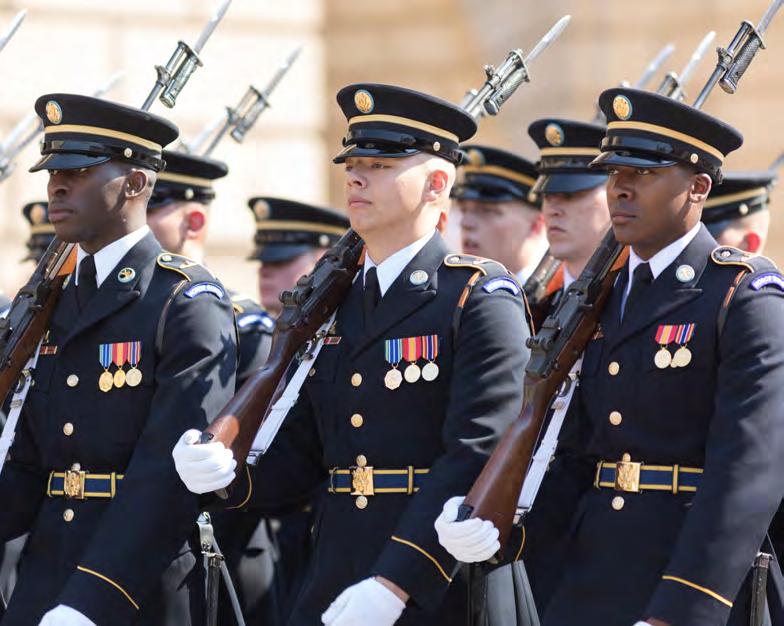
Parade in Pasadena this past January in the form of a float entitled: This We’ll Defend: 250 Years of Service.
The U.S. Army Heritage Center Foundation in Carlise, PA, an honored Smithsonian affiliate research library and museum, is planning a birthday dinner on June 14, 2025. Guest speakers and the 28th Infantry Band will entertain ticketholders.
The National Museum of the United States Army in Belvoir, VA, is
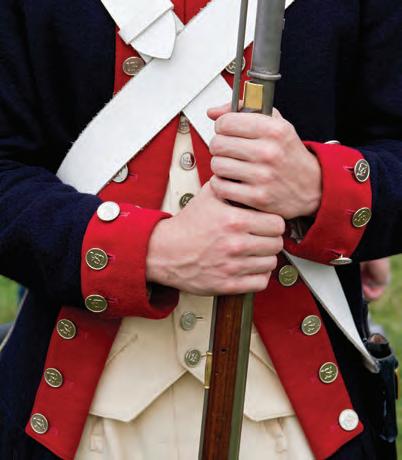
showcasing a special exhibit entitled Call to Arms: The Soldier and the Revolutionary War, which will include a rare collection of Revolutionary War artifacts from the original colonies, as well as England, France, and Canada, along with soldiers’ personal stories from America’s first veterans. The exhibit begins in May and is set to run through the birthday of America in 2026. Virtual attendance is possible.
….For where’er you go, you will always know that those Caissons go rolling along. (From the official song of the United States Army, The Army Goes Rolling Along).
Join Cantigny Park in Wheaton for a day of family fun on Saturday, June 21, from 10:00 a.m. to 4:00 p.m. as they celebrate the 250th Anniversary of the United States Army.
Meet active-duty soldiers, play in an inflatable booth camp, make camouflage crafts, and step back in time to see soldiers’ gear throughout history.
Tours of the First Division Museum, gardens and grounds and Colonel McCormick’s weapon collection are ongoing throughout the year.
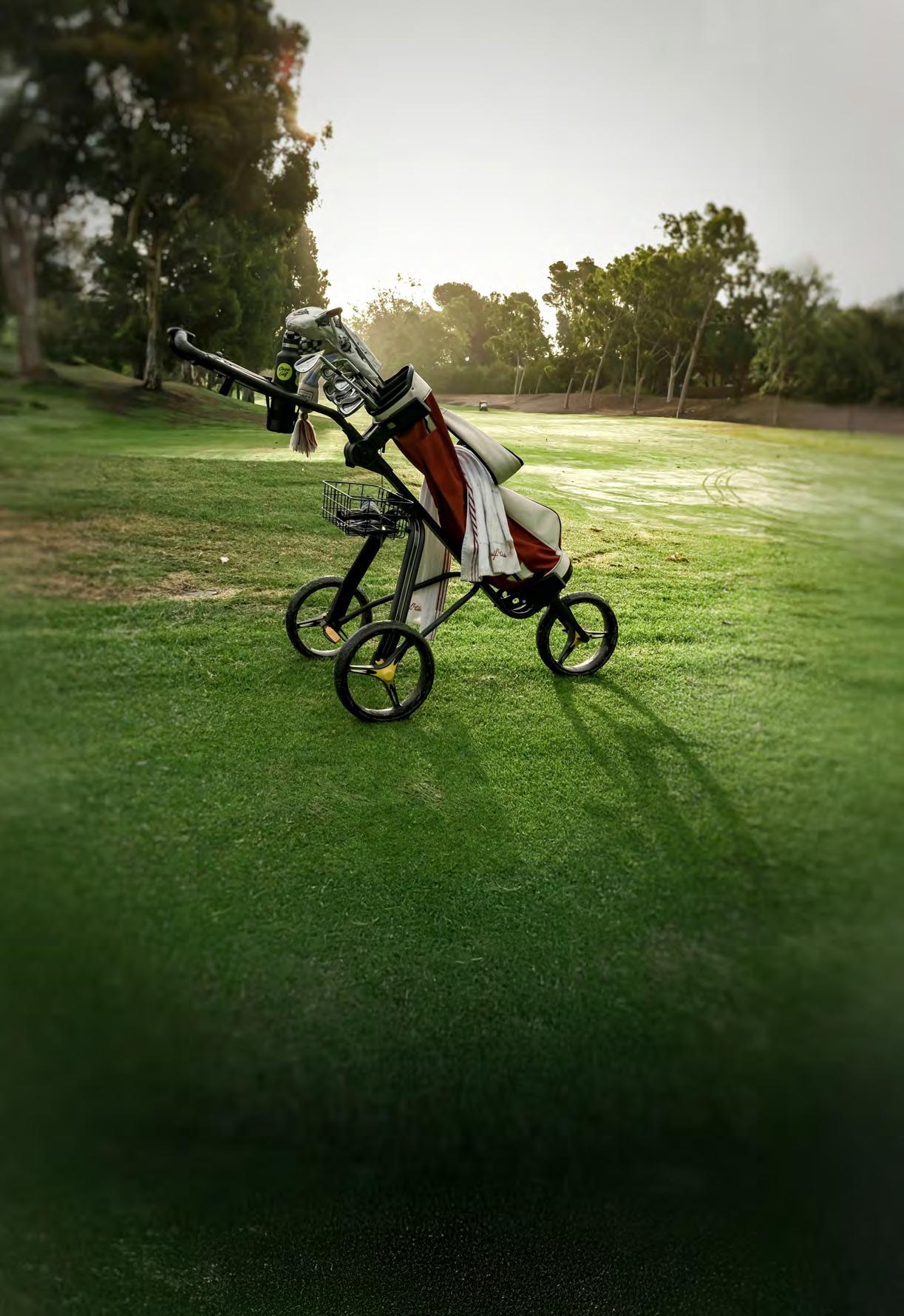
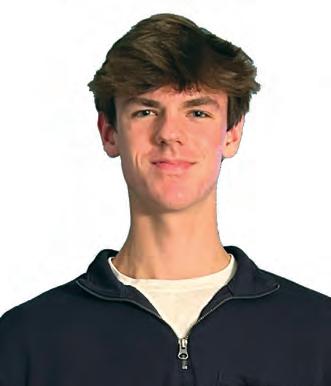
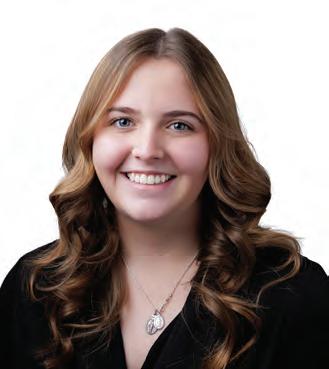

an estimated 360 more awarded the Evans Scholarship this year.
The Scholarship was founded by Charles “Chick” Evans Jr., who was introduced to golf while caddying at Chicago’s Edgewater Golf Club in the late 1890s. Evans went on to become one of the nation’s top amateur golfers and was urged to turn professional, but he was not interested in golfing for money. To retain his amateur status, Evans put his golf earnings into an escrow fund, which he decided to use to finance educations for hardworking caddies whose families could not afford college.
In 1928, Evans asked the WGA to oversee the fund, and the first round of Evans Scholarships were awarded in 1930, sending two caddies to Northwestern University. Until World War II, all Evans Scholars attended Northwestern, the site of the first Evans Scholarship House. When Evans’ original investment was exhausted, WGA Directors made contributions of their own to continue the Scholarship Program.
HOW DOES THE EVANS SCHOLARSHIP PROGRAM
CONTINUE ITS IMPACT TODAY?
The WGA still runs the Evans Scholarship Foundation, which
issued approximately $37 million in Scholarships this year. Evans Scholarships are funded by contributions from over 38,000 Par Club members across the country, proceeds from WGA championship golf tournaments, and donations from some of the more than 12,285 Evans Scholar alumni.
Cummins, Finn, and Hamblin all said receiving the Evans Scholarship has been “life-changing” and working as a caddie has been invaluable.
“Caddying made me so much more confident.”
– MATTHEW HAMBLIN, 2025 NEW EVANS SCHOLAR
Cummins started caddying at River Forest Country Club at age 13 and is one of 11 caddies in her extended family. She said, “I swore up and down that I would never be a caddie – I’m not an outdoorsy person and I don’t like the heat – but I saw my cousins get up and work, making good money and some even got the Evans Scholarship, and I thought it sounded like a good gig!”
Hamblin began caddying at River Forest Country Club as a “shy
freshman” along with friends who decided to try it out as a summer job. “Caddying made me so much more confident, opened many new doors, and helped me…make so many great connections,” he explained.
Finn has caddied at Hinsdale Golf Club for three years and keeps coming back thanks to the “inclusive and supportive members” and the connections he has made with them. Finn also appreciates how flexible caddying is. He runs cross country and track for his school and said, “The Club made it very easy for me to work while having practice every day.”
Finn will attend the University of Illinois to study sports management, Hamblin the University of Iowa to major in finance and accounting, and Cummins Marquette University to major in biomedical sciences.
No prior knowledge of golf is necessary to become a caddie. An orientation program trains new hires on caddying expectations, rules and regulations, and more.
Young men and women interested in caddying may check the club locator on the WGA website (wgaesf.org) to find a participating club.■

BY CONTRIBUTING PARTNER MAINSTREET REALTORS
As the ground thaws and Chicagoland’s yards begin to awaken, homeowners have a golden opportunity to transform their properties and capture the attention of potential buyers. Curb appeal isn’t just a buzzword—it’s a critical factor that can significantly impact your home’s marketability and final sale price, especially during the busy spring real estate season. Whether you’re looking to sell or just keep your house looking its best this season, here are some tips that can help.
The journey to an eye-catching exterior begins with a thorough assessment. Walk to the street and view your property with fresh eyes. Chicagoland’s communities are known for their distinctive charm. Ensure your home reflects the character and care typical of the community it’s stationed in.
Landscaping is your most powerful tool. After the harsh winter, your yard likely needs some TLC. Start by cleaning up—remove fallen branches, dead leaves, and any winter debris. Then, create a crisp and clean edge around your yard’s perimeter, and consider a fresh layer of mulch in garden beds.
Don’t underestimate the power of pressure washing. Our region’s winters can leave siding, driveways, and walkways looking dingy. A thorough cleaning can make your home look years younger, removing salt stains, mud, and winter grime. Pay special attention to windows—clean, sparkling glass reflects well-maintained pride of ownership.
Color can dramatically transform your home’s exterior. A fresh coat of paint on your front door can work wonders—consider bold yet sophisticated colors like deep navy, forest green, or even pure black to send the message that your home is updated and on-trend. Matching this with updated hardware creates a cohesive and inviting entrance.
Symmetry and strategic landscaping can elevate your home’s visual appeal. While you likely don’t want to invest a ton in landscaping just before you move, there are small things you can do to make a big difference. Potted plants flanking your entrance, well-trimmed shrubs, and a manicured lawn create a sense of order and intentionality. Native plants like purple coneflowers, black-eyed susans, and ornamental grasses thrive in our climate and create maximal impact with minimal cost.
Remember, curb appeal is about creating an emotional connection that helps potential buyers envision themselves in your house. Happy selling! ■

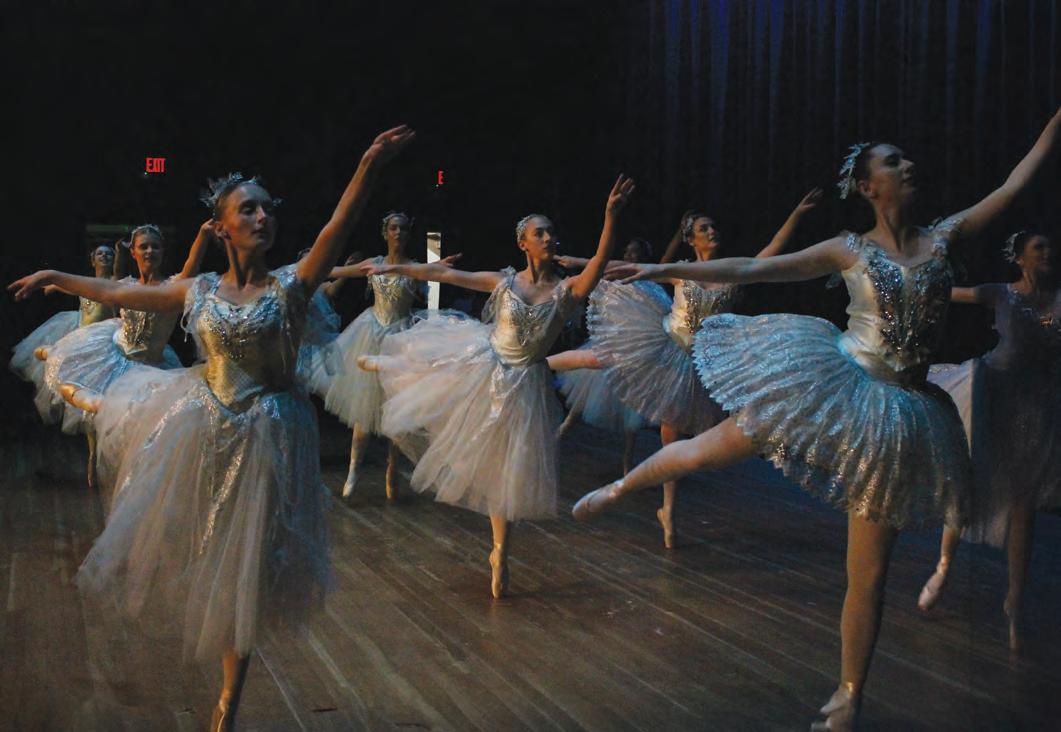
BY LAURA MICHAUD & MELISSA G. WILSON
According to the National Institute of Mental Health (NIMH), approximately 1 in 5 adults live with a mental illness each year. The most common mental health conditions include anxiety disorders (31.6%), major depression (15.3%), substance use disorders (18.1%), and bipolar disorder (2.5%), which can significantly impact daily life, relationships, work, stress management, and basic activities. In severe cases, mental health issues can lead to substance use and suicide.
Sadly, only 50% of adults with mental illness receive any treatment.
Deb Soszko, Board Certified Music Therapist and Director for Dynamic Lynks Music Therapy, stated, “The hardest part of therapy is recognizing the need for support. Once acknowledged, it gets easier. Just stating the scary part out loud makes the next step seem like going downhill.”
Performing arts plays a significant role in supporting mental health, with many powerful tools available that most are unaware of. These tools foster creativity, reduce
anxiety, build self-esteem, and offer a sense of belonging.
Music Therapy helps patients reach emotional balance through expression with lyrics. Songs tell stories, allowing people to hear they’re not alone, and solutions can be found for emotional wellness. Freedom Sings USA (501(c)3) is a great example of an organization that uses music therapy for veterans and their families to create outlets for their stories through the process of songwriting.
Dance Therapy releases endorphins, encourages emotional expression, and offers a healthy outlet for pent-up feelings. Dance is proven to improve cognitive function and reduce dementia risk. Geni Lucchesi, DuPage Dance Academy’s Director, reflected, “Because dance involves mental effort, social interaction, and movement, a multitude of studies indicate this stimulation significantly reduces the risk of dementia.”
Soszko discusses a session at an eating disorders clinic where women were hunched over and quiet at the start. She asked them to dance with their eyes closed, picturing themselves as the person they wanted to be. After this 3-minute exercise, the women stood
taller, and self-expression flowed freely. “Once completed, their words just started flowing. They were saying, “I really think I can do this. Why can’t I? Who says I can’t?”
Theater Arts Therapy combines arts and therapy. For those struggling to express themselves or process experiences, art becomes a vessel to connect with emotions and express pent-up feelings. According to Azizi Marshall of the Center for Creative Arts Therapy, “We use acting and improv as therapeutic tools. Whether through non-verbal communication or role-playing, it allows people to articulate and understand feelings they may otherwise have difficulty expressing.” ■
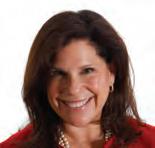

About the authors: Laura Michaud is a founding member of the Encore Center for Performing Arts and founder of Chicago theaters and the Belmont theater district. Melissa G. Wilson is a performing arts enthusiast, author, and renowned networker. For more information visit ECPA-Elmhurst.org and Networlding.com.
On March 9, 2025, hundreds participated in the 32nd Fight for Air Climb at Oakbrook Terrace Tower, Illinois’ tallest building outside Chicago. Climbers ascended 30 floors and 660 steps, supporting the American Lung Association’s mission for clean air and healthy lungs. The Oak Brook Fire Department participated in the event, including team members Jeffrey Kushner, Seth Bowlan, John Fagan, and Johnny Walylko. The “OBFD Street People” team raised over $1,000 to support the American Lung Association. Other corporate supporters included Inland Real Estate Group, the Oak Brook Chamber of Commerce, Alter Brewing + Kitchen, Fogo de Chao, Castle Automotive, the Oak Brook Park District, Custom Ink, J.C. Anderson, and Bosch.
